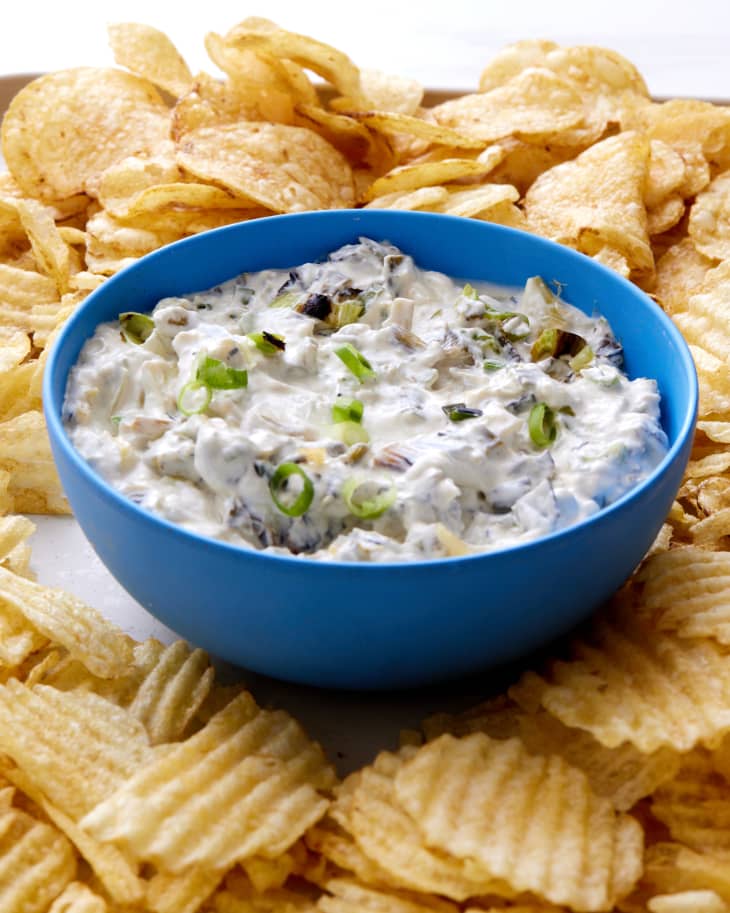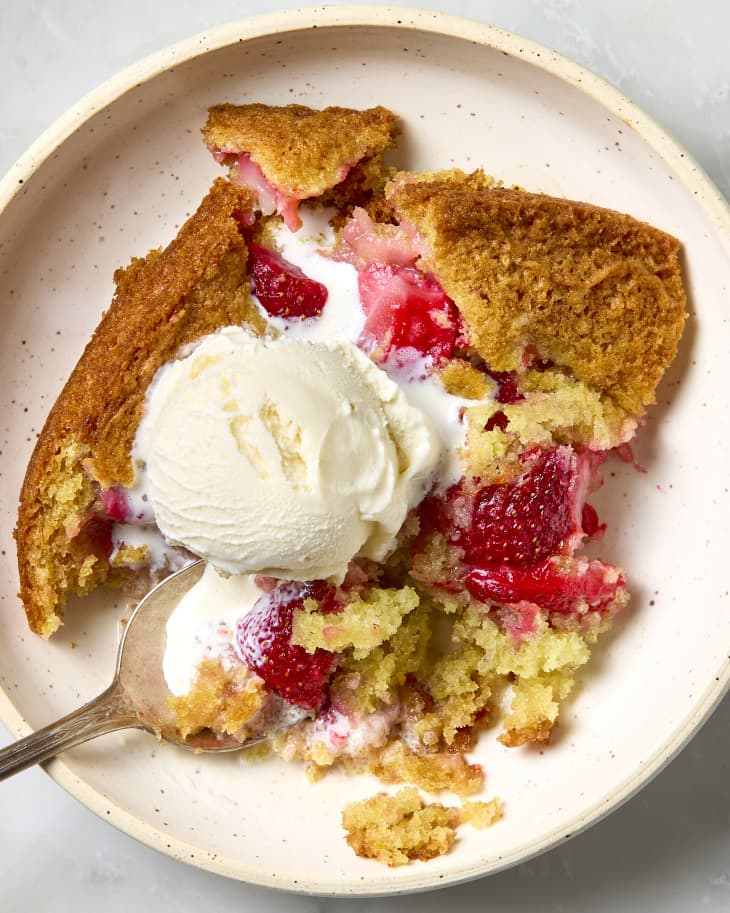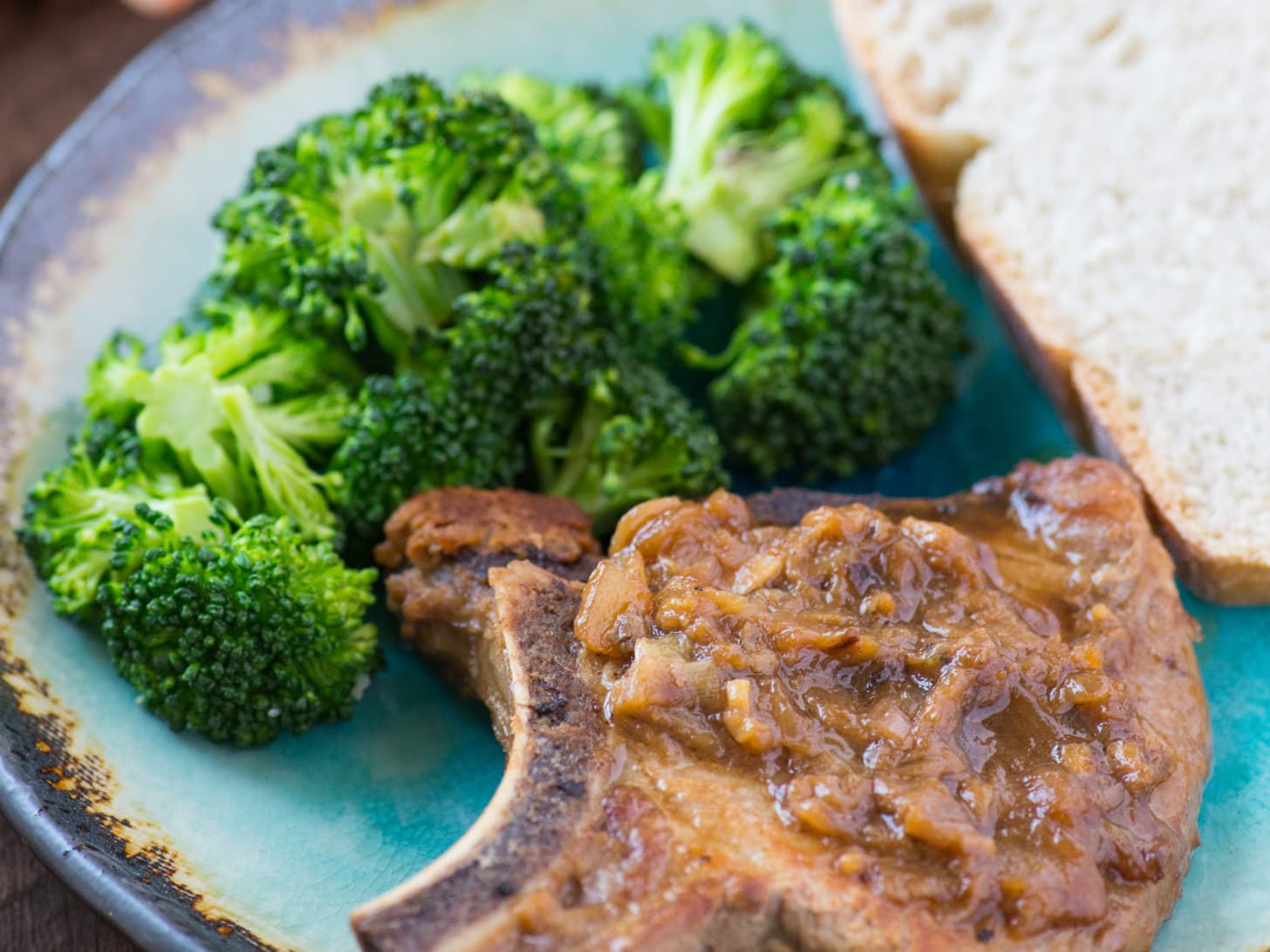Blog
Final Spring Share delivery! Weekly & BW/B
- On: July 02, 2025
 0
0
Folks, this wraps up our six-week Spring Share. Thank you for joining our short adventure! We are so glad to feed you. We hope you enjoy the rest of the summer, and find other sources of local food.
What can you expect next from us?
– You will be able to come to the farm for at least one u-pick of organic plum tomatoes. This usually occurs around Labor Day. We plan to have garlic and basil for sale too, so you can make tomato sauce. Maybe some red peppers as well.
– We expect to offer pop-up sales as these crops are ready: plum tomatoes, basil, garlic, #2 grade red bell peppers. Watch for emails from us. The pop-up sales are likely to occur in August and/or September, with delivery to a few sites in Madison, plus pickup here at the farm.
 The melon fields are doing well. We should have melons at the Willy Street Coops by early August.
The melon fields are doing well. We should have melons at the Willy Street Coops by early August.
You can buy our produce at these local stores.
We are currently delivering zucchini, cucumbers, cabbage and greens locally. Soon we will add peppers, then watermelons. By fall and winter, we will have a full suit of storage crops like cabbage, carrots, beets, and other root crops.
– the Willy Street Coops
– the Vitruvian Farm store (sometimes)
– After October, Outpost Natural Foods in the Milwaukee area.
Looking for another CSA farm to join for summer or fall?
Try the FairShare CSA Coalition’s Farm Search page. The map is quite useful and you can filter by season.
This week’s cabbage

Cabbage harvest involves lots of throwing. From right, Ken and Pollo cut the cabbage and throw to Maggie. Maggie throws to Aly on the wagon. Simone drives and sets a steady pace. For bigger fields, we gather a larger team and use our field conveyer instead of throwing.
 How’s that for trust? Maggie throws backhand to Aly, knowing that she’ll catch it and that Ken is about to toss her the next one.
How’s that for trust? Maggie throws backhand to Aly, knowing that she’ll catch it and that Ken is about to toss her the next one.
Veggie List & Veggie Notes
Week #6, July 3, 2025
– Weekly shares
– BiWeekly/ B group
Green cabbage, 1
Sugar snap peas, ~0.8 lb
Zucchini &/or yellow squash, ~4 lb
Cucumbers, 5 – 6
Fennel, 1 or 2 bulbs, with fronds
Kohlrabi, 1 medium bulb
Lacinato kale, 1 bunch
Scallions, 1 bunch
Basil, 1 or 2 sprigs
Green cabbage – We grew ‘Farao’ variety for you. It is a delightful salad cabbage, good for slaw.
Storage: Refrigerate.
Fennel (bulbs and lacy fronds) – Fennel is a ‘swing vegetable’; it can be used raw or cooked. Clean well and slice as thinly as possible for use in raw salads. It is good simply prepared with olive oil, lime or lemon juice, salt and shaved parmesan cheese. Cooking softens and sweetens fennel, and mellows its anise flavor. Both the bulb and leaves are edible. Here are ideas from Alice Waters of Chez Panisse about how to use fennel: ‘It’s strong anise characteristic seems to suit fish particularly well. … We use fennel all the time. We add the feathery leaves to marinades for fish and to numerous salads, sauces and soups and we use them as a garnish, too. … The bulbs are sliced and served raw in salads in various combinations with other vegetables, parboiled for pastas; caramelized and served as a side dish; braised whole; or cooked in vegetable broths & fish stocks.”
Kohlrabi (pale green, round vegetable with thick skin and attached leaves) – Crunchy and sweet, kohlrabi is a great addition to salads.
Storage: Kohlrabi bulbs will store for a month in the refrigerator.
Uses: Kohlrabi are good peeled and eaten out of hand, or added to sandwiches, or added to salads. It makes a nice salad on it’s own. You can grate it, slice it, or cut it into matchsticks. It’s also good cooked.
Lacinato kale (bundle of grey-green textured leaves) – This is our most beautiful cooking green and a super food! Use like any kale.
Storage: Cover and refrigerate.
Basil (branched, leafy stalk) – Everyone gets one or two sprigs. Weekly members, it will be obvious to you that basil from this planting fared better than last week’s basil. Last week’s basil experienced too many temperature fluctuations, too much wind. This week’s basil is more tender. This stuff is fragile!
Storage: Basil deteriorates if stored in the refrigerator. It is best stored at room temperature with the cut ends in water, for example in a jar or vase. Treat it like a flower. Give the stem a fresh trim and change the water every day or two.
RECIPES by DEB
summer squash gratin with salsa verde
From smitten kitchen

In the notes for this recipe, Deb Perelman of smitten kitchen points out that although we refer to the yellow version as summer squash and the green version as zucchini, both are actually summer squash and can be used interchangeably. The salsa verde uses thyme, dried oregano or marjoram, mint, and flat leaf parsley. Since we have basil in the box I suggest subbing that in for the mint and some or all of the flat leaf parsley. Made with basil, the salsa verde will brown more quickly, but most of it is going into the gratin, where it won’t show. Store any leftover salsa verde with a thin layer of olive oil or a piece of saran wrap on the surface. If there is fennel in the box, it would be tasty sliced and sautéed and added to the gratin.
.
.
Sushi Salad with Brown Rice, Avocado & Nori
From Alexandra’s Kitchen
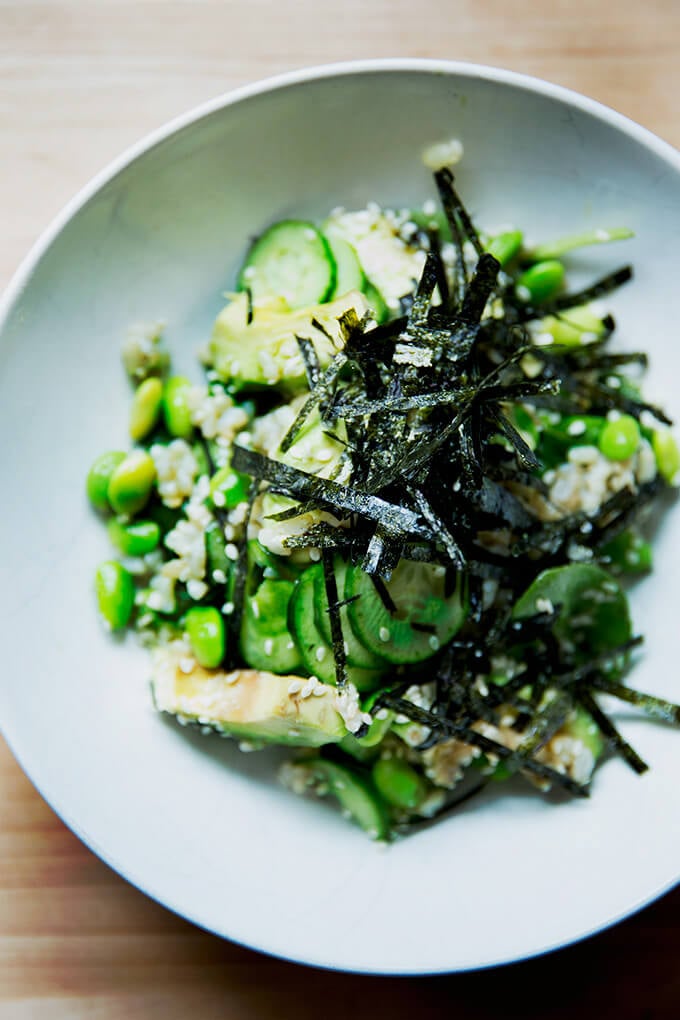
Here is the first of two recipes for sushi salad, rice salads where some of the typical ingredients for sushi are tossed together as a salad rather than made into a roll. The recipe, from Alexandra’s Kitchen, includes nori, the seaweed that’s often used a wrapper for sushi rolls, but uses fewer of the veggies from this week’s box. You can sub sugar snaps for the edamame and regular cucumber, peeled and seeded, for the Persian cucumber called for.
.
.
Scattered Sushi Salad
From Mollie Katzen

Scattered Sushi Salad from Mollie Katzen is probably more Americanized, but because it focuses on the rice, it’s preferred by anyone like me, who who thinks the rice is the best part of the sushi. You can also use more ingredients from our box for this one, cucumbers, summer squash, sugar snap peas, scallions, garlic scapes, finely sliced kale.
.
.
Super-Simple Tangy Buttermilk Coleslaw Recipe
From Serious Eats
:max_bytes(150000):strip_icc()/__opt__aboutcom__coeus__resources__content_migration__serious_eats__seriouseats.com__recipes__images__2015__08__20150815-buttermilk-slaw-1-f7bbd15ae7344322b99c69c1d07b8432.jpg)
This recipe recommends salting and draining your shredded cabbage before adding the dressing, which removes a lot of the liquid from the cabbage and prevents the dressing from getting watered down. Sliced scallions can replace the red onion.
.
.
Basil Cucumber Salad
From Whole and Heavenly Oven

Creamy cucumbers with basil is slightly different than the usual seasoning of this salad, usually dill or no herbs at all. If you don’t have red onions, you could use scallions instead.
.
.
Cold Cucumber Soup Recipe
From Love and Lemons

From the always-dependable Love & Lemons blog, this soup is an extremely elegant way to serve your cucumbers on a hot summer’s day. It calls for Persian cucumbers which are seedless; I recommend that you peel and seed our cukes. To seed cucumbers, cut them in half lengthwise and scoop out the seeds with a spoon. There’s also both fresh dill, that we do not have in the box, and basil that we do, in the recipe. You could simply omit the dill or use dried dill – I suggest starting with 1/2 teaspoon and adding more to taste.
.
.
Cheesy Zucchini Enchiladas
From DebsLunch Recipes

A mix of zucchini and summer squash cooked in olive oil is the filling for these enchiladas. A recipe for a tomato-y sauce is provided, as well as links to a ground chili-based enchilada sauce and a ranchero sauce. This recipe is very flexible and suggestions for additions to the filling are also provided.
Week #5. Final BiWeekly/A group box.
- On: June 25, 2025
 0
0
Who grows your food?
 From left, Ben, Pollo, Steve, Aly, Simone, Ken, Maggie, Beth and Ava. MIA that day, Ari, Madelline and Ida.
From left, Ben, Pollo, Steve, Aly, Simone, Ken, Maggie, Beth and Ava. MIA that day, Ari, Madelline and Ida.
 The crew picks collard greens for this week’s delivery. From left, Maggie, Madelline, Ben, Aly and Ida.
The crew picks collard greens for this week’s delivery. From left, Maggie, Madelline, Ben, Aly and Ida.
Let’s acknowledge the group working hard to grow good quality produce for you. Our farm is staffed by a group of experienced farm hands and managers, plus me and Steve. These individuals have worked for us from one year to 27 years. They know so much about growing good produce.
We all enjoy the work (or aspects of it) but the recent weather has been rough; too hot for us, too hot for the crops. We are grateful for the rain that fell this week, as many storms had passed us by, and grateful that it came relatively gently, unlike other storms in the area. Wash your lettuce with extra care this week. It has grit from the storms.
Strawberries are finished.

A string of 95 degree days, followed by heavy rain, ended our strawberry crop. They are too delicate for that. I am sad that we don’t have berries for the CSA boxes this week, but that gave us time to pick lots of peas for you instead. I am happy we could offer multiple u-picks for you to pick for yourselves. It was a nice field. We’ll be back with berries next year.
A woodlot for the woodlot


The maple trees are growing!

The new woodlot is a mix of hardwoods (in protective tubes) and conifers (without tubes).
I planted many new trees and shrubs this spring. Seventy-two trees in a new woodlot, plus 35 flowering shrubs near our east border. The shrubs will be beautiful in spring.
The woodlot is more functional. The woodlot protecting our house and buildings was damaged in a February 2024 tornado, the first February tornado in Wisconsin. Fortunately, the tornado just missed our buildings, greenhouses, etc. Its path across our farm (and neighboring farms) was evident in downed trees in each fence line.
It was weeks before I realized that the woodlot behind our house had sustained damage too. Basically, the funnel must have picked up, gone over the top of the woodlot and house, then came down again out in the fields. It came so close to our house! One day I looked up and realized that I could see daylight through the trunk of every tree, near its top. Across the woodlot, each tree had a gap at the same angle and same height. Every storm since brings down more trees or snaps them at the damage line. There are some healthy trees in there but the lot has been greatly thinned.
It was time to plant a new woodlot to protect the remaining woodlot. I planted a mixture of conifers and hardwoods, with lots of sugar maples for future maple syrup gathering. Also, hackberries, basswoods, serviceberries and a few oaks, all species that do well on our farm. This is fun for me. I think it will be more fun if we have steady rain, so I don’t have to spend so much time watering. Protecting, mulching and watering the trees takes as much time as planting, but are all essential for survival. This is a longterm project.
Thanks for reading,
Beth
Veggie List & Veggie Notes
Week #5, June 26, 2025
– Weekly shares
– BiWeekly/ A group
Sugar snap peas, 0.8 lb
Snow peas, ~1/2 lb
Zucchini &/or Zephyr yellow squash, 2.5 to 3 lb
Collard greens, 1 large bunch
Cucumbers, 2
Romaine lettuce
Kohlrabi, 1 large
Basil, 1 small sprig
Scallions, 1 bunch
Next week’s box will probably contain snap peas, green cabbage, cucumbers, zucchini & squash, snap peas, kale, basil, scallions and more.
Snap peas and snow peas – See photo below, to tell them apart. Both require stringing. Snap off the stem end and pull the string down the concave side of the pod (the inward-curing side). Throw away the string and eat the pod. The thicker pea pods might have a string along both edges.
Storage: Refrigerate.
Collard greens – These grew well in the recent hot weather. Strip out the tough midvein before cooking, like you would with kale.
Storage: Cover and refrigerate.
Cucumbers – We have been waiting for these!
Storage: Store at room temperature for a few days or refrigerate in the warmest part of your fridge. Cucumbers get chilling injury if stored too cold.
Romaine lettuce – This batch has grit from recent storms and will need care when washing. I recommend cutting them dunking in a basin of water. Repeat with fresh water or until the water is clear.
Kohlrabi (pale green, round vegetable with thick skin and attached leaves) – Crunchy and sweet, kohlrabi is a great addition to salads.
Storage: Kohlrabi bulbs will store for a month in the refrigerator.
Uses: Kohlrabi are good peeled and eaten out of hand, or added to sandwiches, or added to salads. It makes a nice salad on it’s own. You can grate it, slice it, or cut it into matchsticks. It’s also good cooked.
Basil – We washed the basil very gently. Expect to wash it again to remove grit. This batch is tender and flavorful but showing all its life experience; cold weather under row cover, strong winds under row cover, strong winds without row cover, heavy rain. You notice that I don’t mention hot weather. It takes that in stride. Next week’s basil is beautiful.

Sugar snap peas (left) and snow peas (right).
RECIPES by DEB
Caramelized Zucchini Pasta
From Grilled Cheese Social
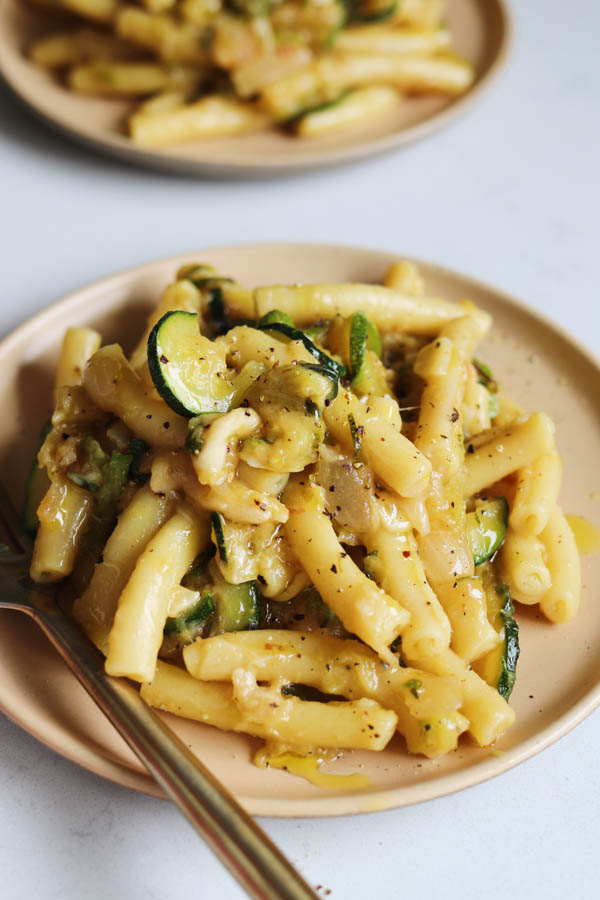
This pasta is quite similar to smitten kitchen’s zucchini butter spaghetti in terms of ingredients, but rather than grating the zucchini (or yellow squash), the squash is sliced. Personally I think slicing makes a prettier dish, but grated or sliced, these recipes transform a pile of zucchini into a pile of pasta! The three medium zucchini called for add up to about 1 1/2 to 1 3/4 pounds of zucchini.
Kohlrabi Remoulade: A Fresh Take on a Classic Salad
From Umami Girl

Classically, it’s celery root that is cut into a julienne and dressed with remoulade sauce; here kohlrabi, which is crunchier and juicier, takes the place of the celery root. If you don’t have a mandoline, you can grate the kohlrabi or cut it into matchsticks with a sharp knife. For a more traditional and slightly orange-r remoulade, see this Serious Eats recipe.
.
.
Easy Chicken Club Lettuce Wraps
From YellowBlissRoad.com
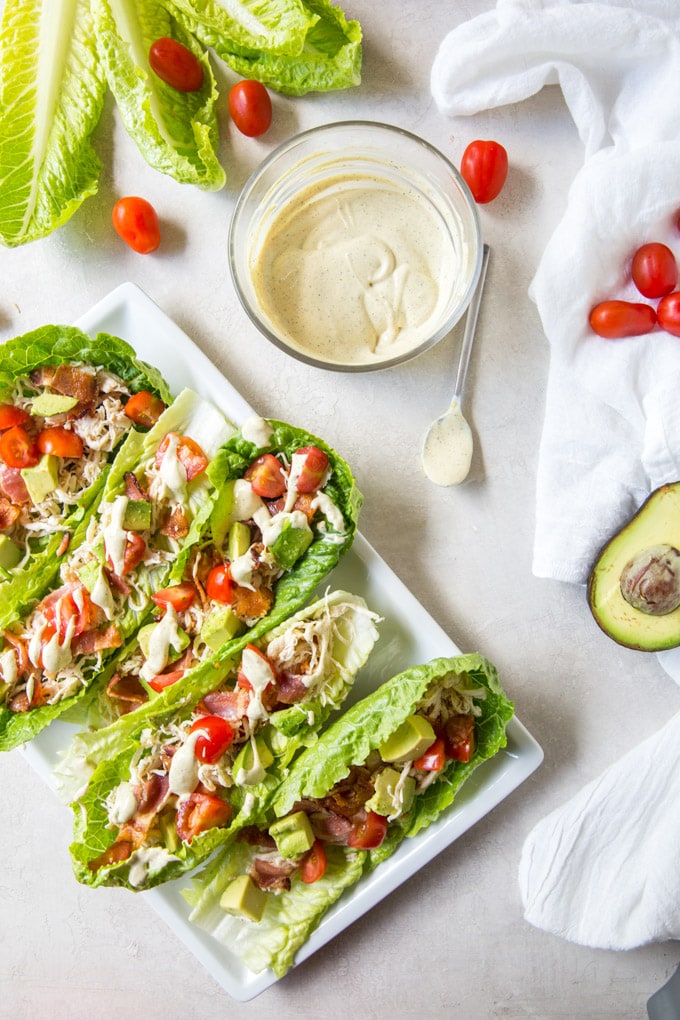
You could sub in purchased chicken- or not-chicken nuggets to fill these wraps if you like, or instead of making wraps, you could make a big salad with the same ingredients. The dressing provided here is a 50/50 mix of Dijon mustard and sour cream, great on a wrap, but if you go the salad route, I suggest jazzing it up a bit with some sliced scallions and basil from the box, and a few tablespoons each of red wine vinegar and olive oil.
.
.
Chili Crisp Snap Pea Salad
From Munching with Mariyah

Combine the sugar snaps and scallions from this week’s box with a few pantry staples like chili crisp and sesame oil to create this crunchy salad (control the heat by reducing the amount of chili crisp or omitting). If you have cilantro from last week, it goes in the salad, or sub this week’s basil instead. If you don’t have any edamame in the freezer, just skip it and consider adding chopped roasted peanuts as a topping.
.
.
Stuffed Collard Green Roll Ups Recipe
From LeelaLicious
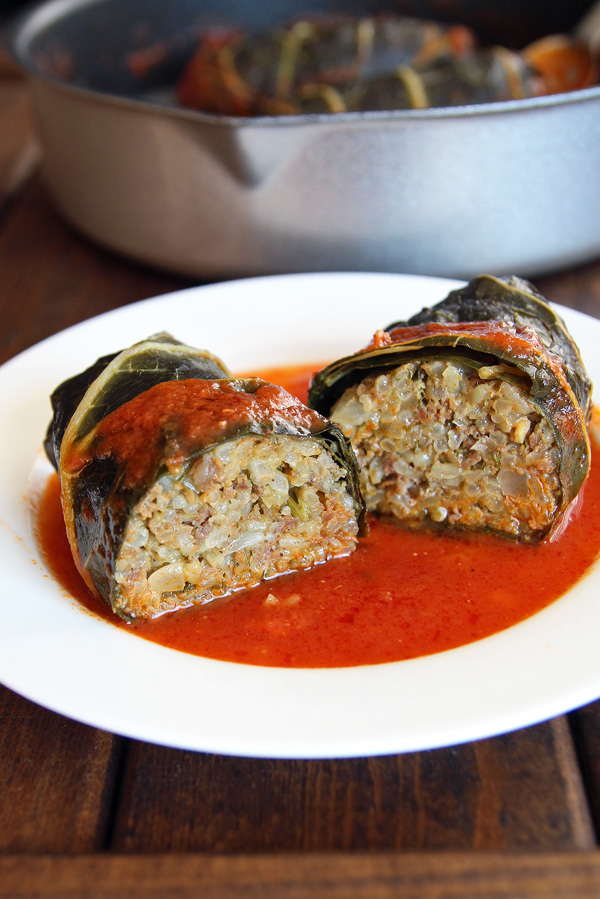
Collard leaves are easier to stuff than cabbage, since they start off flat. These rolls have a ground beef filling, but you could sub any ground meat. There’s also bacon in the tomato sauce, which sounds delicious but if you don’t eat pork, at the point in the recipe where you set the collard rolls on top of the bacon strips in a skillet you could simply use butter or olive oil, then pour your favorite tomato sauce over.
.
.
Sour Cream and Charred Scallion Dip
From The Kitchn
Forget the Lipton’s, make your next batch of chip dip with charred scallions! And as the recipe suggests, in addition to serving the scallion dip with potato chips, try it on veggies, like sugar snaps, snow peas, or kohlrabi sticks. You can also spread it on a sandwich or use as salad dressing.
.
.
Scallion-Corn Muffins
By Colby Garrelts and Megan Garrelts for Food and Wine
:max_bytes(150000):strip_icc()/scallion-corn-muffin-XL-RECIPE1117-b1f6cd752a254da499d676b07fd1a7ce.jpg)
Photo by John Kernick
Scallions and cornbread are such a great combination they go with just about any meal. We don’t have local sweet corn as yet, but frozen works just as well in this recipe. Note that although the pictures shows six muffins, the recipe actually makes 24. If you don’t need that many muffins, cut the recipe in half or freeze the extras.
Week #4. Strawberries continue.
- On: June 18, 2025
 0
0

Erika and Jessica, the owners of Giant Jones Brewing Company, came to pick berries this week, to make into organic strawberry soda. How cool is that? Jessica has worked on her concoction for a few years and says it’s low in sugar and high in flavor. I can’t wait to try it. Erika was the executive director of FairShare CSA Coalition for many years. Any farmer gatherings in Madison tend to gravitate to their brewery.
We picked lots of berries too! Thanks to everyone who came to the farm u-pick this past weekend. That was one of our best u-picks. The berries and weather were both perfect. Everyone was in a great mood and the plants were loaded. I neglected to take any photos. Shoot. Believe me, it was a good, good day.
The later berries are still coming on strong. Check your email for this week’s u-picks. These might be our final u-picks. It depends on the weather and the upcoming heat could be hard on the berries. We do hope to pick again for next week’s CSA boxes.
Napa cabbage
 Your napa cabbage started to flower, so we harvested it a bit early. There’s a flower stalk in the middle that you can snap out or chop and include in your cooking. The stalks that I checked were all quite tender. Bolting (early flowering) happens when you grow napa cabbage, bok choy and other Asian greens in spring. Alternating temperatures stimulate the plants to flower. The long days in June play a role too. Fall-planted napa rarely bolts. The cilantro this week is also trying to flower, but is still very nice.
Your napa cabbage started to flower, so we harvested it a bit early. There’s a flower stalk in the middle that you can snap out or chop and include in your cooking. The stalks that I checked were all quite tender. Bolting (early flowering) happens when you grow napa cabbage, bok choy and other Asian greens in spring. Alternating temperatures stimulate the plants to flower. The long days in June play a role too. Fall-planted napa rarely bolts. The cilantro this week is also trying to flower, but is still very nice.
Veggie List & Veggie Notes
Week #4, June 19, 2025
– Weekly shares
– BiWeekly/ B group
Strawberries, 1 quart
Sugar snap peas, 1/2 lb
Zucchini &/or yellow summer squash, 2.25 – 2.5 lb
Napa cabbage
Red bibb lettuce
Bok choy, 1 medium
White salad turnips, 1 bunch
Cilantro, 1 small bunch
Scallions, 1 bunch
Next week’s box will probably contain strawberries (weather permitting), snap peas, snow peas, kale or collards, zucchini & summer squash, Romaine lettuce, scallions and more.
Sugar snap peas. These peas should be eaten pod and all. They are delicious raw, or very lightly cooked or stir-fried.
Preparation: They will need a quick rinse to remove faded gray blossoms. Here’s how to remove the strings on each pod. Snap off the stem end and pull the string down the concave side of the pod (the inward-curing side). Throw away the string and eat the pod. The thicker pea pods might have a string along both edges.
Storage: Refrigerate.
Zucchini & summer squash – Zucchini and summer squash need refrigeration but do not do well at very cold temperatures, as they will soften and form pits in their surface. Refrigerate these squash but in the warmest part of your fridge.
Napa cabbage (large, pale green cabbage with crinkled leaves) – Napa cabbage is an interesting vegetable, useful for both fresh, raw salads and for cooking. Its most famous use is fermented kimchi. I like to prepare a fresh, unfermented kimchi. Same seasonings, but it’s ready to eat right away. You will be amazed at how much shredded napa cabbage shrinks when prepared this way. See here for an example, but cut the salt in half (or even further): Grilled Flank Steak with Kimchi-style Coleslaw.
Storage: Napa stores very well. When refrigerated, it will keep for several weeks. Peel off the outer layer and it will be ready to use. Here are a few preparation ideas from the ‘Asparagus to Zucchini’ cookbook.
– Chop raw napa into green salads.
– Substitute napa in traditional coleslaw.
– Chinese cabbage cooks quickly. Steam 3-5 minutes, or until leaves are wilted down but remain slightly crisp.
– Substitute napa cabbage for common cabbage in recipes, but reduce the cooking time by 2 minutes.
– Napa cabbage is the main ingredient in egg rolls. Try making an egg roll mixture to eat as a cooked side dish instead of preparing time-consuming egg rolls.
Red bibb – Look at that gorgeous lettuce! It is visually stunning, as well as tender and delicious.
Cilantro (small bunch, fragrant leaves) – Used in both Mexican and some Asian cuisines. Good to season stir-fries, salad dressing, salsa, etc.
Storage: Cover and refrigerate.
RECIPES by DEB
Pasta with Smashed Zucchini Cream
From 101 Cookbooks
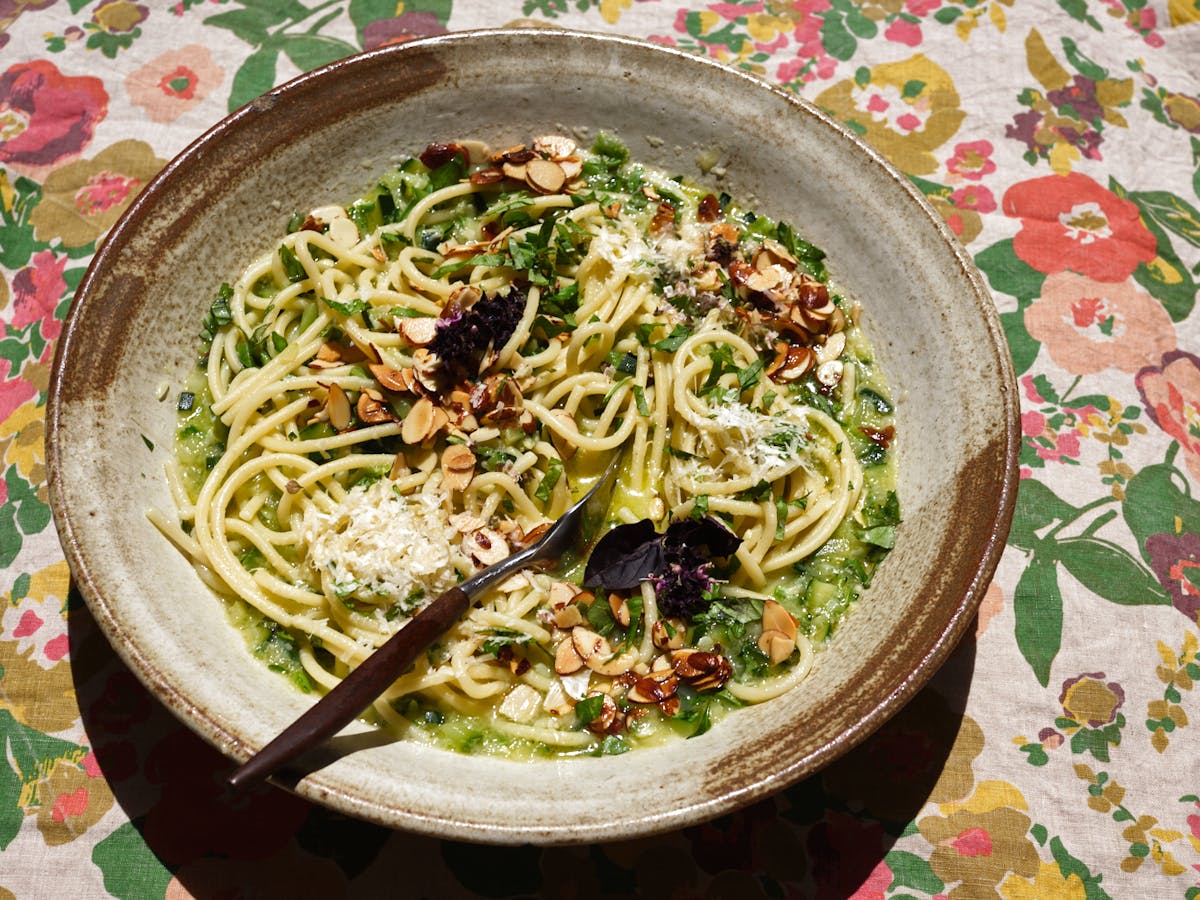
Here’s an interesting way to use your zucchini, as the pasta sauce rather than chunks of vegetable in the sauce. The recipe calls for fresh basil, but you could sub cilantro or parsley, or stir in a few tablespoons of pesto, if you have some. Or simply omit the basil! The recipe comes from Heidi Swanson of 101 cookbooks, a vegetarian recipe blog that’s been online since 2003, and there are 20+ more ideas for zucchini here.
.
.
Old-Fashioned Strawberry Spoon Cake Recipe
From The Kitchn
Photo by Alex Lepe, Food Styling: Rachel Perlmutter
Our beautiful strawberries don’t really need to have anything done to them – except eating! But here’s a quick cake that really gilds the lily – or strawberry – and it only uses about a cup of strawberries to make dessert for six, so you will still have strawberries to eat plain.
.
.
Turnip Gratin Recipe
From Simply Recipes

Photo by Elise Bauer
The salad turnips in this week’s box are sweet and tender enough to eat raw, but here’s a way to dress them up that should even appeal to people ambivalent about turnips!
.
.
Lemon Buttermilk Dressing
From Foodess

In honor of the tender red leaf lettuce and salad turnips in this week’s box, here’s a recipe for a buttermilk dressing that’s tasty on a variety of spring vegetables. Try it on a salad with the red bibb lettuce, salad turnips, sugar snap peas, radishes if you still have any, and enjoy!
.
.
Napa Cabbage Salad
From Forks Over Knives
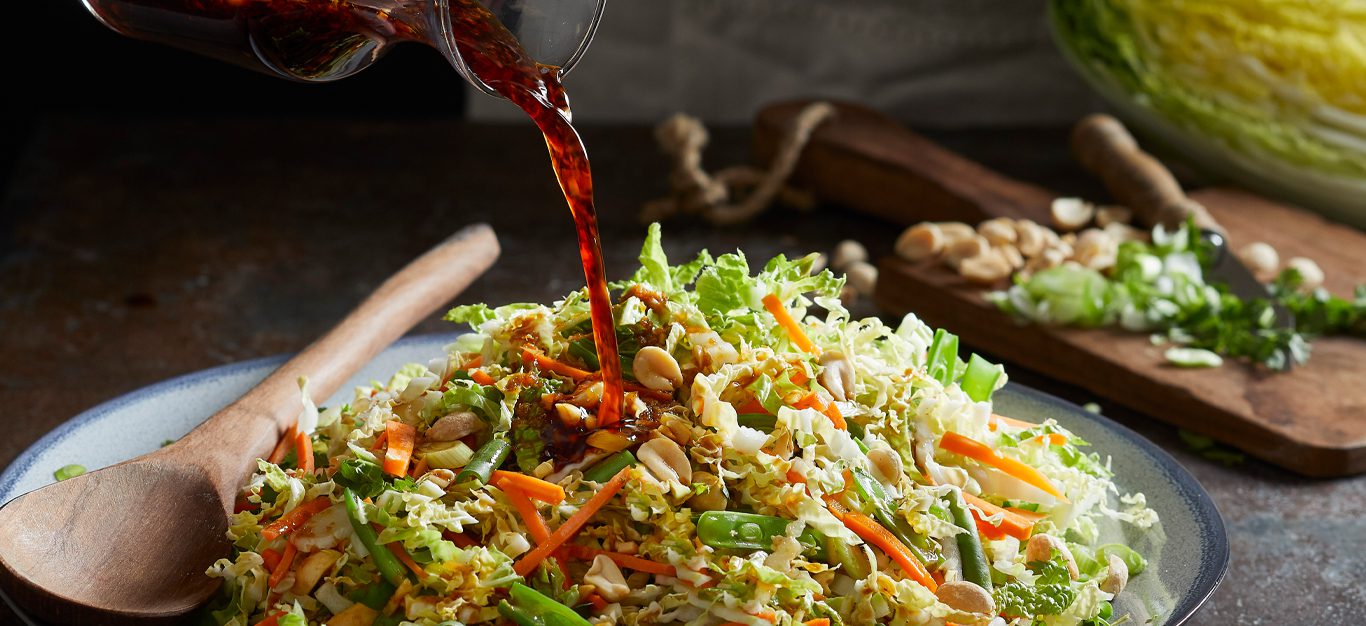
Here’s a nice crunchy salad using the Napa cabbage, scallions, and cilantro in the box. Sugar snaps can stand in for the green beans and some julienned turnip would be a nice addition.
.
.
Pizza With Zucchini, Feta, Lemon, and Garlic Recipe
From Serious Eats
:max_bytes(150000):strip_icc()/__opt__aboutcom__coeus__resources__content_migration__serious_eats__seriouseats.com__recipes__images__2015__07__20150702-zucchini-pizza-worth-eating-10-dfa07ad4eb9a4b648cb47853f2dd4acd.jpg)
Photo by J. Kenji López-Alt
Zucchini as a pizza topping – with a lot of its moisture removed. This recipe calls for feta and mozzarella cheese, but you could sub in other good melting cheeses if you wish. It also features LOTS of garlic, lemon, and scallions for garnish. The recipe makes four small 8-inch pizzas, using 2 pounds of purchased pizza dough or a recipe to make your own dough is provided. You could also buy ready made crusts – there’s probably enough topping for two 12-inch crusts – or use purchased naan or no-pocket pita bread for your pizza base.
.
.
Roasted Napa Cabbage with Crispy Tofu
From Jackfruitful Kitchen

Here’s an interesting way to prepare our Napa cabbage. I have not tested the grated tofu, but see no reason why it would not work, especially with extra firm tofu. If you’re uncertain about preparing the tofu this way, I suggest cubing it, boiling it briefly in enough water to cover, drain well and proceed with the recipe. Boiling is a sure way to remove enough water from the tofu so that it will crisp. You can sub white wine or sherry for the Mirin and soy sauce or Tamari for the coconut aminos.
.
.
Cilantro Lime Rice Recipe
From Love and Lemons

This rice would be a nice side dish alongside your favorite protein or other vegetable main dish. You could also try throwing a few handfuls of rinsed and stringed sugar snaps on top when the rice has about 10 minutes to go, before step 2 in the recipe. The peas will be lightly steamed by the time you fold in the additional ingredients listed in step 2.
Week #3. Big berry week.
- On: June 11, 2025
 0
0

The crew picks your strawberries. It’s a beautiful patch this year.

All your berries are ripe, even if one side is white and the other colored. This is normal for the ‘Cavendish’ variety. Eat one that looks like this and you will understand that they are ripe.



Happy u-pickers this past weekend. I gotta say, I like our reservation system. It keeps our u-picks calm and manageable with a small staff.
Strawberry u-picks
We expect to host an organic strawberry u-pick in coming days.
RESERVATIONS ARE REQUIRED.
U-pick price: $4.00/lb
Tipi CSA members, follow instructions in an email that I sent you this week. Non-members, if we have enough capacity, we will offer reservations directly to our email list and (perhaps) on our berry page. Join our email list for direct notification.
Veggie List & Veggie Notes
Week #3, June 12, 2025
– Weekly shares
– BiWeekly/ A group
Strawberries, 2 quarts
Asparagus, ~2/3 lb
Button mushrooms, 12 oz
Baby bok choy
Zucchini, 2 or 3 ct.
Spinach, 1 bunch
Romaine lettuce
White salad turnips, 1 bunch
Salad radishes, 1 bunch
Scallions, 1 bunch
Next week’s box will probably contain strawberries, zucchini &/or summer squash, leafy greens, scallions and more.
Strawberries – Eat soon. Strawberries are perishable and these are delicious right now. I encourage you to avoid washing these berries. Rinse any berries that have soil on them, but the rest do not need washing. It only shortens their storage life.
Storage: Refrigerate.
Button mushrooms – These organic mushrooms are from Hidden Valley Mushrooms from Wisconsin Dells. We buy mushrooms from Mary and Ed every spring because they combine so perfectly with our spring vegetables, for salads, quiches, etc.
Storage: Here are Mary’s suggestions for storing the mushrooms:
– Store separate from leafy greens, which hasten mushroom aging.
– If storing for more than a few days, remove from the box and refrigerate in a paper bag with holes punched in the side. Keep dry.
– Don’t wash to clean, just wipe with a damp cloth.
Baby bok choy – We continue experimenting with adorable baby bok choy. My favorite preparation is to slice lengthwise into quarters (or sixths or eighths depending on size). Steam in a steamer basket until tender. Dress with a simple vinaigrette of rice vinegar, soy sauce, sugar, sesame oil and hot pepper flakes. There are lots of recipes online with steamed mushrooms and baby choy.
Storage: Cover and refrigerate.
Scallions (bundle of green onions) – These are useful raw or cooked. Thinly-sliced raw scallions can be folded into biscuit dough or sprinkled on top of soups or salads. Terrific garnish for pasta dishes. Think pad thai.
Notes and storage for these vegetables in previous newsletters. Info will be under “Veggie List and Veggie Notes”.
Asparagus
Spinach
White salad turnips
Salad radishes
How to wash lettuce and other greens efficiently
RECIPES by DEB
Spring Vegetable Stir Fry
From Making Thyme for Health

This recipe calls for half a pound each of mushrooms and asparagus, and a cup of sliced radishes, all of which we have in the box, and the notes point out you should feel free to sub what you like. This means the zucchini, bok choy, and salad turnips would all be nice additions. Personally, I think salad turnips are very tasty in stir fry’s.
.
.
Red Radish Crostini with Lemon Ricotta
From Vanilla Bean Cuisine

Here’s a fun appetizer to use up some of our supply of radishes – that could also be lunch with maybe some fruit or a salad. Pairing radishes with something creamy, like ricotta, is always a hit. Try spreading halved radishes with a little cream cheese and sprinkling with coarse salt and fresh ground pepper for another easy snack.
.
.
Banh Mi Sandwich Recipe
From Love and Lemons
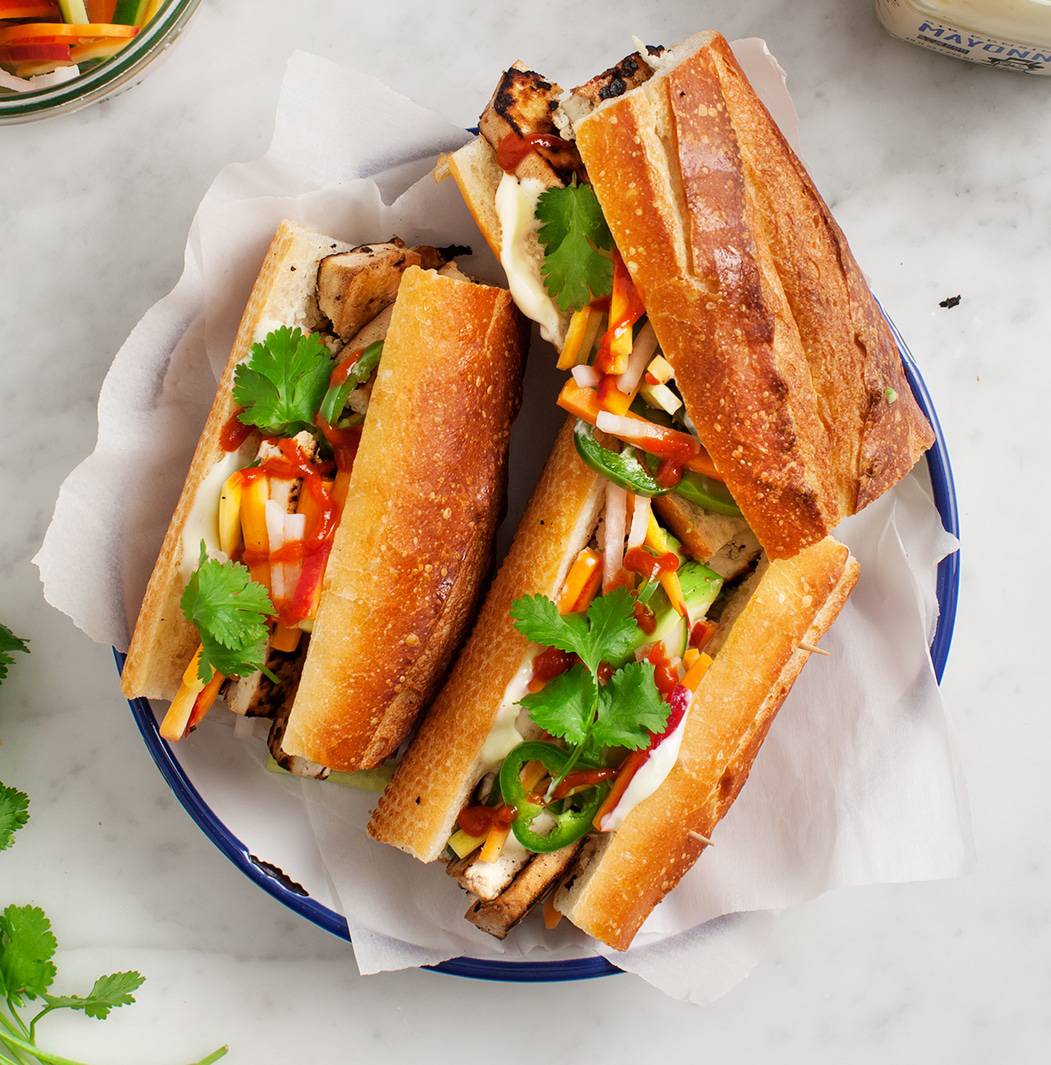
The pickled veggies that fill this Bahn Mi sandwich include Daikon, cucumber, and carrots, but you can sub red radishes for the Daikon (the recipe suggests this) and turnips for the cucumber. Add carrots if you have them, or simply use more radishes and turnips. You’ll probably have extra pickled veggies that are good on avocado toast or in tacos.
.
.
Easy Brown Rice Risotto with Mushrooms
From Cookie and Kate
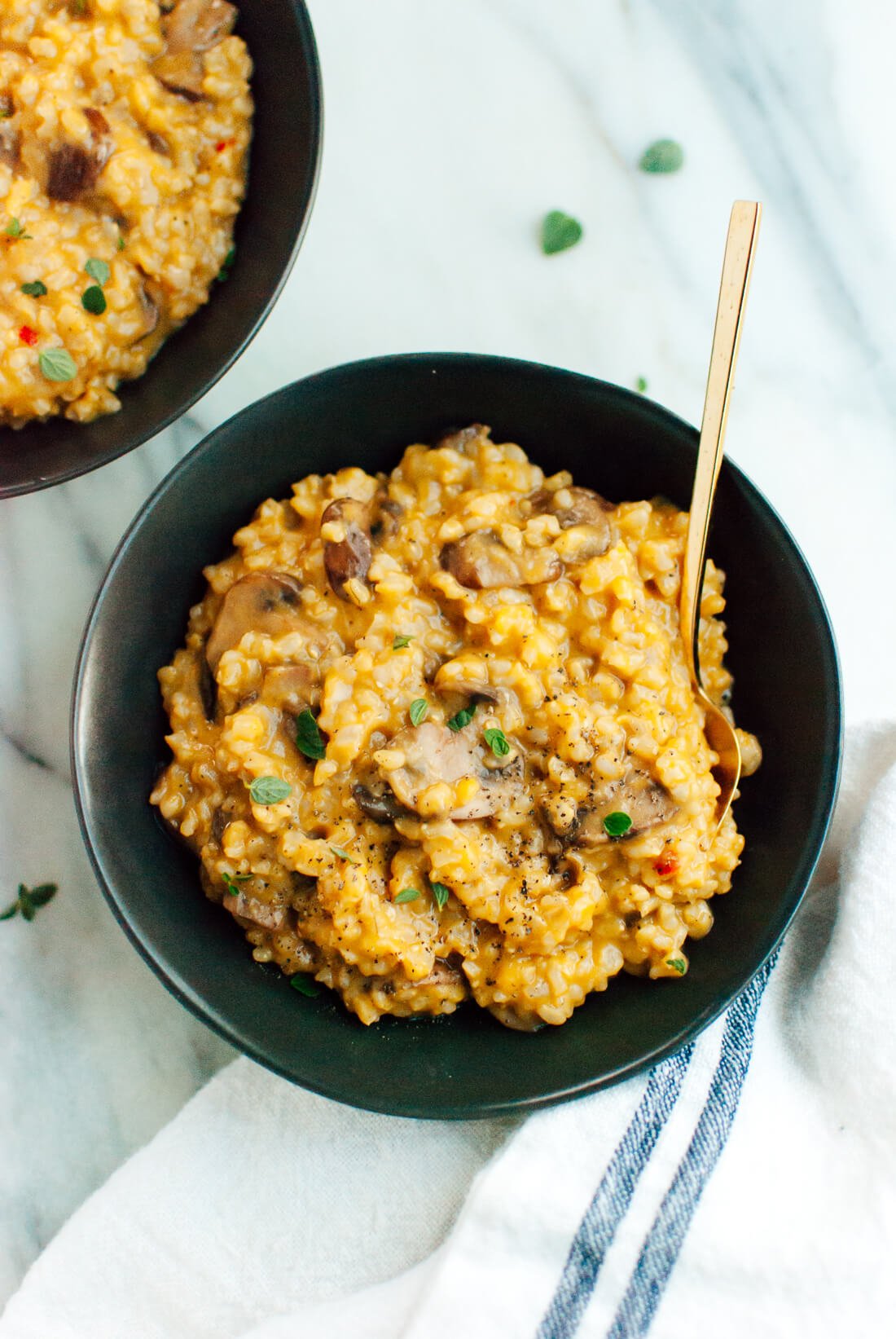
Here’s a way to make risotto without stirring! And the recipe is very forgiving. The first time I made it, I had a friend visiting who doesn’t eat onions or pepper, so I left both out, and didn’t miss them. Similarly, omitting the fresh oregano will not decrease the flavor of the dish. Thinly sliced scallions from this week’s box would be a nice garnish, along with some asparagus on the side. The short-grain brown rice that’s called for in the recipe is delicious, but if you don’t have it, long grain will work.
.
.
Fresh Turnip & Greens Quiche with Almond Crust
From Dishing Up the Dirt
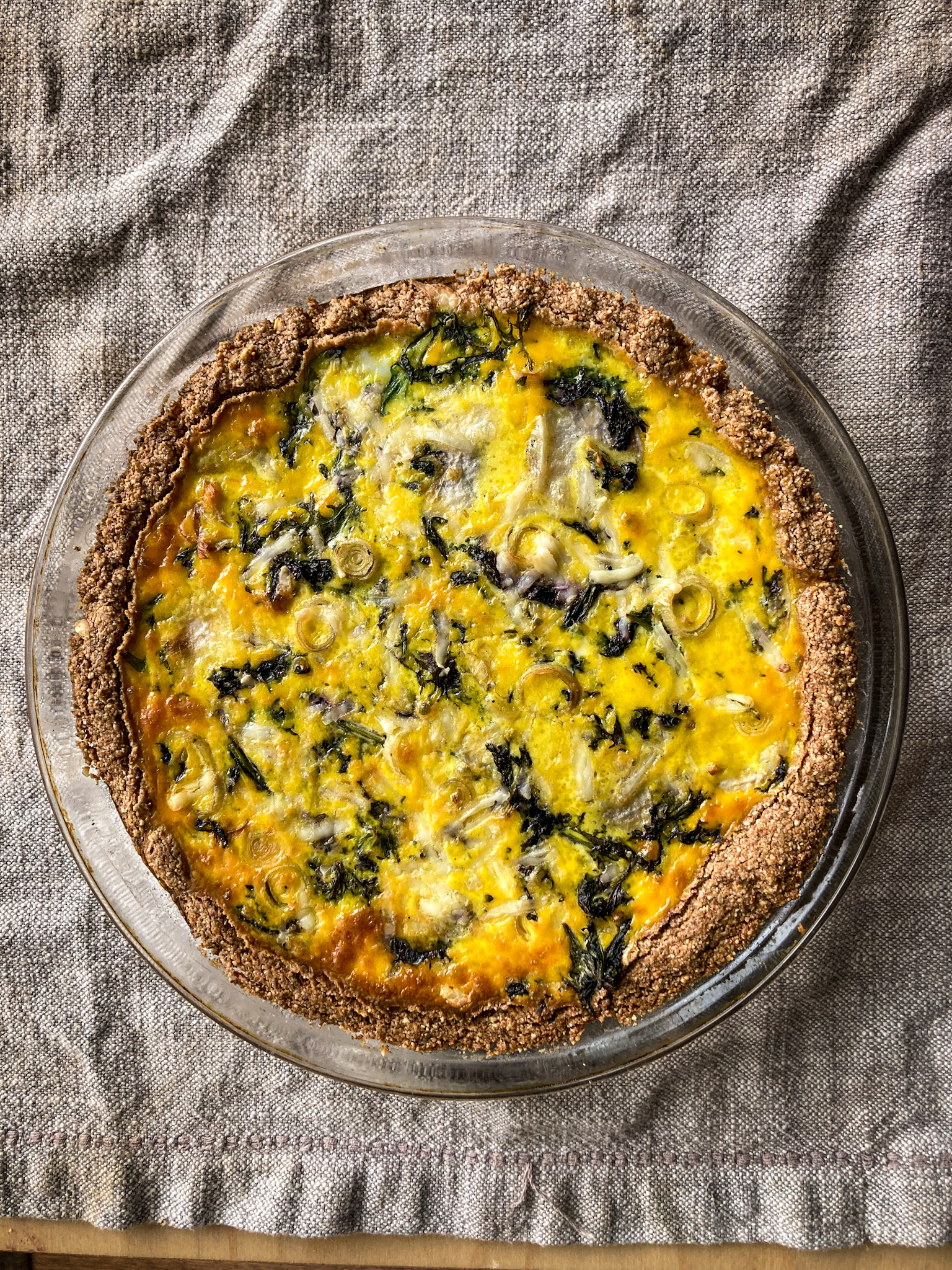
This quiche has a patted-in almond flour crust that’s gluten free, but you could sub your favorite rolled crust if you like. The recipe calls for turnip greens, but you could also use spinach from the box, and sub scallions for green garlic.
.
.
Easy Asparagus Egg Bake with Mushroom and Swiss Cheese
From Honey and Birch
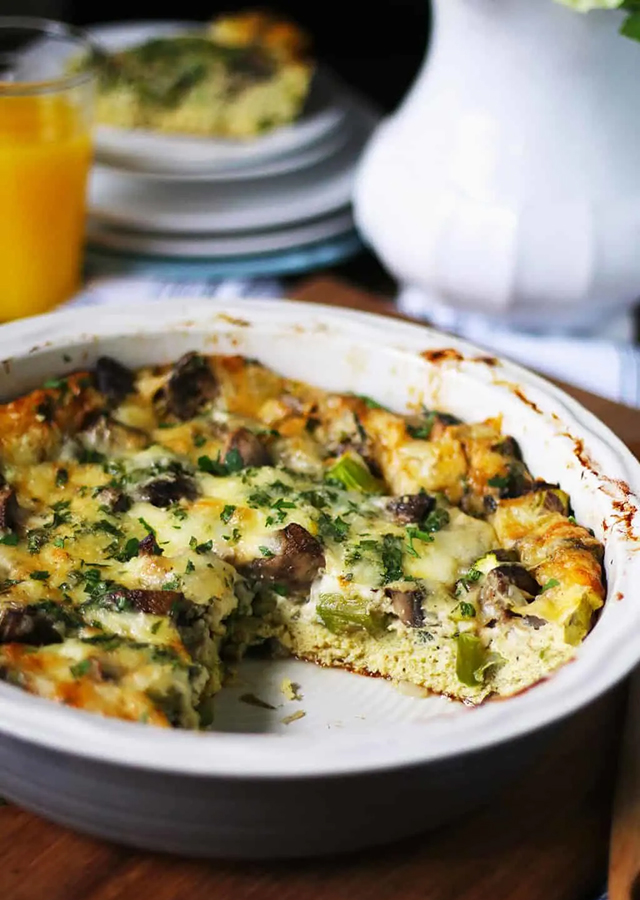
Combine the asparagus and mushrooms from this week’s box with eggs and cheese to make this brunch dish. A handful of spinach and/or some chopped zucchini would also be a nice addition.
.
.
Roberta’s Romaine Salad with Candied Walnuts and Pecorino
From Serious Eats
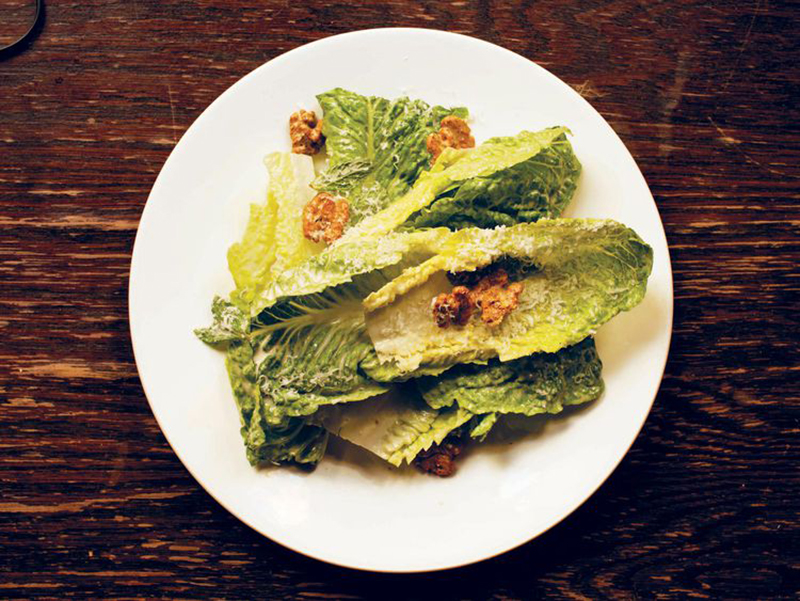
Photo by Dave Potez
Roberta’s is a wood-fired pizza place in Brooklyn NY, know for its salads as well as its pizza. This recipe make A LOT of dressing and candied walnuts, more than is needed for one head of Romaine, but they’re good leftovers to have. As the recipe points out, you can serve the walnuts as part of a cheese board, and the dressing is good on any salad made with sturdy greens, like the spinach in this week’s box.
Week #2. Weekly+BW/B. Fox kits.
- On: June 04, 2025
 0
0
We pack produce this week for these shares:
– Weekly shares
– BiWeekly/ B group
Fox kits
For the first time, we have a fox family living on the farm. I guessed foxes as soon as I found the den. The den itself is substantial but the abundant trails, skat, and rabbit legs really gave it away. Lots of gnawed groundsquirrel legs too. I was able to capture this snippet of video on our trail camera. They have already moved out of the den but I continue watching for them. View below or on YouTube at youtu.be/zGs1DIS49ow
Organic strawberry updates
Our berry field is progressing very nicely. We expect to begin picking in mid-June. Tipi members, watch our emails for u-pick announcements.
If you are not a Tipi member this year, please join our email list so we can alert you when it’s time to pick. As usual, our u-picks are by reservation only.
Veggie List & Veggie Notes
Week #2, June 5, 2025
Asparagus, 1.25 lb
Shiitake mushrooms, 8 oz
Red leaf lettuce
Spinach, 1 bunch
Komatsuna mustard greens, 1 bunch
White salad turnips, 1 bunch
Salad radishes, 1 bunch
Green garlic, 1 bunch
Rhubarb, 1.2 lb
Next week’s box will probably contain strawberries (weather permitting), asparagus, lettuce, button mushrooms, salad turnips, spring greens, scallions and more.
NEW ITEMS THIS WEEK:
Shiitake mushrooms – These are from Hidden Valley Mushrooms, the same people who grow button mushrooms for us. I love shiitakes cooked with spinach or other greens. Shiitakes must be cooked. A small subset of people can have a toxic reaction to raw or undercooked shiitakes. Once cooked, they are harmless. And tasty! Lightly sauté in butter and add to any dish. We use ours in frittatas, as well as sautéed and mixed into pasta salad or any dish. Sautéed shiitakes and spinach are a great topping for pizza or rice bowls, e.g. bibimbap.
Storage, general: Refrigerate in a dry paper bag, but not in your crisper drawer with other vegetables, especially brassicas. It’s OK to put a loose plastic bag over the paper bag but don’t close. Mushrooms are perishable so use soon.
Komatsuna greens (bundle of dark green leafy heads. &nbs) – These tasty spring greens are similar to mustard greens, with great flavor, but are more mild than mustard greens.
Preparation: Use in any recipe that calls for mustard greens or bok choy. We suggest using just the leaves, as stems are fibrous.
Storage: Cover and refrigerate.
White salad turnips – I know that returning members look forward to these sweet and delicious turnips, which taste nothing like the turnips that are harvested in fall.
– Storage: Cover and refrigerate.
– Uses: Both the turnip roots and tops are edible. The roots are excellent raw; Slice and add to salads. They can be cooked and are especially good when lightly sauteed in butter. Stir as little as possible so they brown on at least one side. The turnips greens are excellent cooked. Treat them like mustard greens.
– Our favorite use: Slice the roots very thinly and combine with a mixture of rice vinegar, mirin, soy sauce, sesame oil. Eat immediately or marinate.
INFO REPEATED FROM LAST WEEK:
ASPARAGUS – This is my favorite spring treat!
Prep: Wash your asparagus thoroughly to remove hidden grit. Submerge in water with the tips pointing down, soak briefly, then swish vigorously and pull out of the water. The draining action helps pull the grit out of the asparagus tips. Repeat several times.
Storage: Asparagus is perishable, so eat it as soon as possible. Store in a paper towel, cloth or paper bag, then wrap loosely in a plastic bag. The paper bag protects the asparagus tips from direct contact with the plastic bag. The plastic bag keeps the asparagus from wilting.
Preparation: We snap our asparagus at harvest, rather than cutting. Therefore, there is no need to snap the stalks to remove fibrous ends. For the same reason, it is not necessary to peel the asparagus stalks. It’s OK to trim the cut end a bit.
Cooking: If your asparagus stalks vary greatly in size, you will want to cook the thicker ones longer. Put an empty steamer pot over water, and bring the water to a boil. Add the asparagus. Cover and steam over medium heat until just tender. Use two forks or a spatula to turn the asparagus during cooking, rotating the bottom spears to the top. Drain and serve. Alternatively, you can lay spears flat in the bottom of a broad pan, with ½ inch of water. Also excellent broiled or grilled. Good dressed with vinaigrette, or with lime juice, salt and pepper.
RED LEAF LETTUCE – The lettuce tender so handle gently.
Storage: Refrigerate in a bag or other container.
SPINACH – This spinach is good for salads or for cooking.
Storage: Refrigerate in a bag or other container.
SALAD RADISHES – These are great in salads or thinly sliced on sandwiches.
Storage: Cover and refrigerate.
GREEN GARLIC (looks like scallions, tastes like garlic) – Last fall, we planted garlic cloves that grew into the stalks we harvested this week. If left to grow until mid-summer, the slim white bulb on this week’s garlic will divide and form the usual cluster of cloves in a garlic bulb.
Preparation: Green garlic is more pungent than scallions, so slice thinly and use sparingly when raw. It mellows when cooked. Chop and add to any cooked dish that would benefit from garlic. Use the white bulbs and pale green stems. Don’t use the dark green stems and leaves, as these are fibrous.
RHUBARB – Storage: Refrigerate in a plastic bag.
Stewed rhubarb: This is the simplest way to prepare rhubarb. Chop rhubarb into one inch chunks. Stir over medium heat with a small amount of water in the bottom of the pan. The rhubarb will release moisture as it cooks. Stew until it softens and falls apart. Sweeten to taste with honey or sugar. Eat warm on its own, over vanilla ice cream, on pancakes, etc.
Storage: Refrigerate.
Preserve: Rhubarb is extremely easy to freeze. Wash, chop and pop it in a freezer bag. That’s it; no need for blanching. When baking muffins or cakes, add the frozen rhubarb directly to the batter.
RECIPES by DEB
Asparagus Mushroom Stir Fry
From Jo Eats
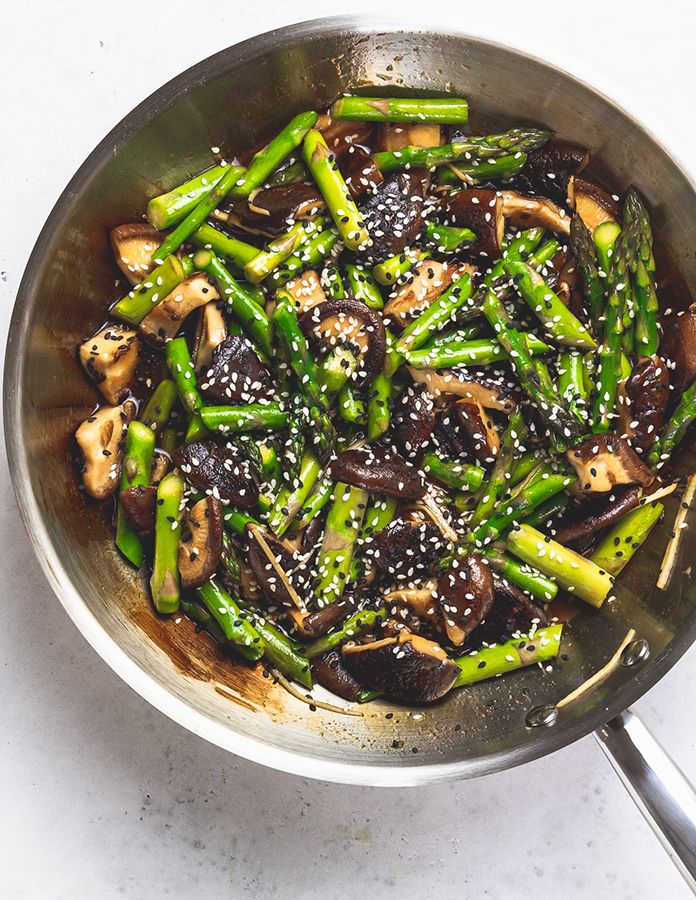
This recipe includes a lengthy discussion of stir fry dinners as well concise instructions for how to make the stir fry, plus it’s perfect for the asparagus and shiitakes in this week’s box. There’re also some really nice photos! If you don’t have a hunk of fresh ginger on hand you could sub about a teaspoon of powdered ginger, or if you happen to have crystallized ginger lurking with your baking ingredients, try chopping that up for your stir fry – the added sweetness enhances the dish.
.
.
Mustard Greens Breakfast Salad With Maple Glazed Turnips & Bacon
From Dishing Up the Dirt
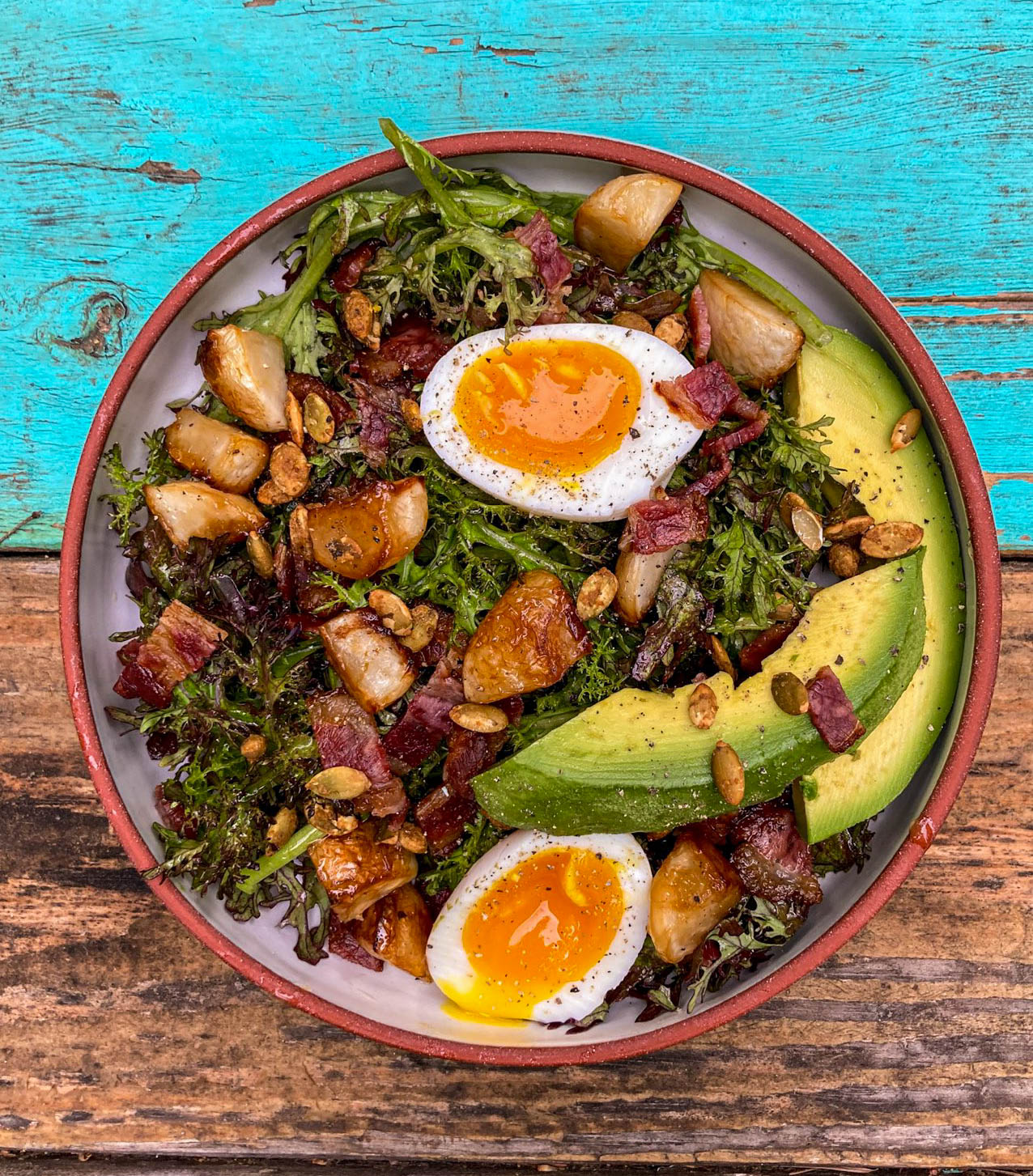
This recipe from Dishing up the Dirt calls for raw mustard greens and maple-glazed salad turnips. The komatsuna in our box is a mustard green, but will probably taste best cooked. Beth suggests using just the komatsuna leaves this week, not the stems. You can decide for yourself if the leaves are tender enough to be eaten raw, or if they need need a little cooking along with the turnips. And despite the “breakfast” word in the recipe title, this dish would be good for lunch or dinner, too!
.
.
rhubarb jam (small batch)
From the farmers daughter

I’ve always frozen lots of chopped rhubarb in-season and also made puree and frozen that, but I think this quick jam might be my new favorite way to preserve spring rhubarb for future use. It has a bit more sugar than rhubarb puree, and can be frozen. I immersion-blendered my batch to smooth it, and thought it might be too thin, but it thickened up nicely when chilled. The jam is delicious on toast or biscuits, and you can also use it to fill jam-bellied scones, the following recipe.
.
.
Jam-bellied Scones
By Deb Perelman of Smitten Kitchen, for King Arthur Baking
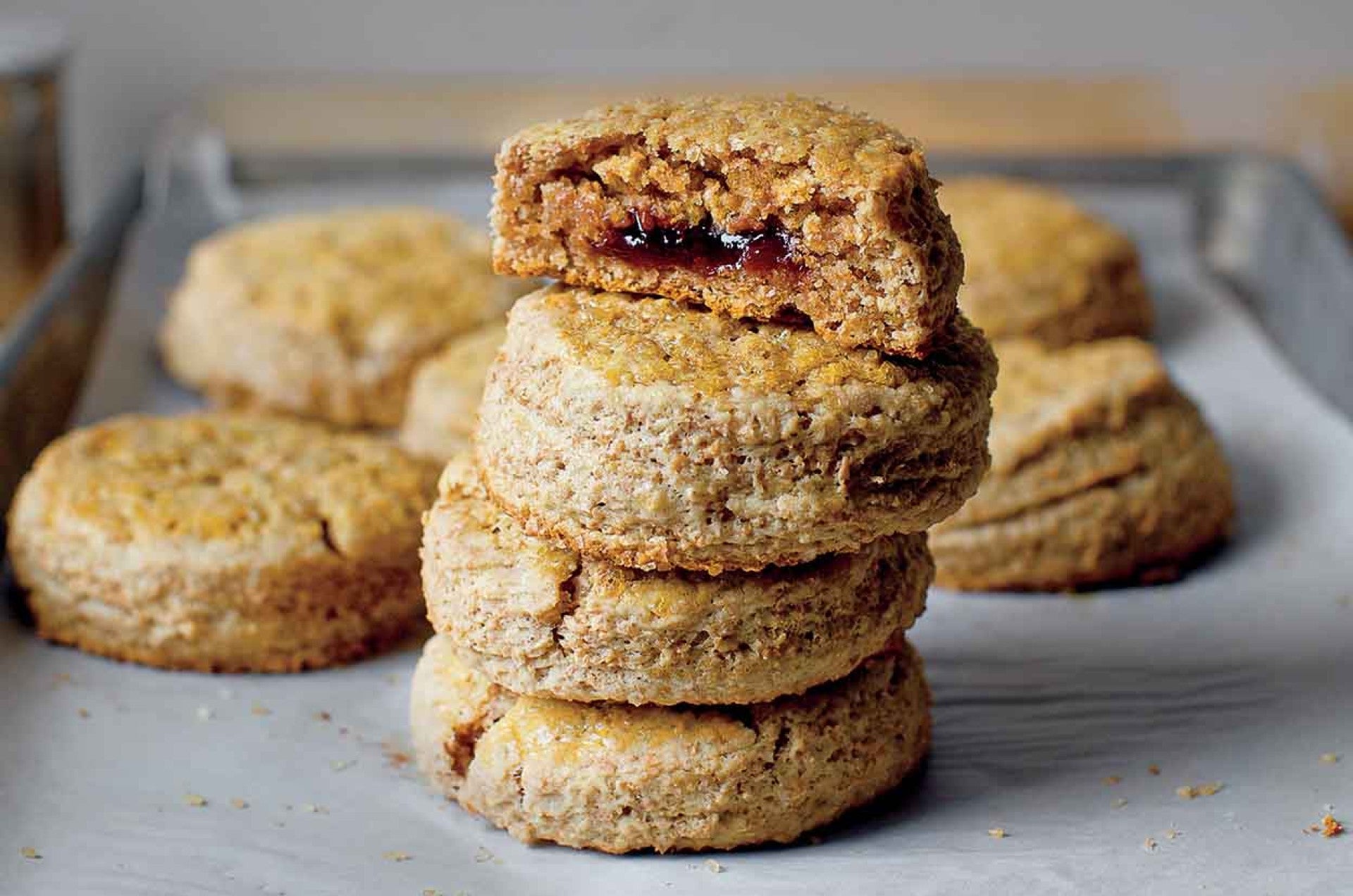
The combination of unbleached flour with bran added back makes a fluffy but wheaty scone, but if you don’t have wheat bran you can use all whole wheat flour, or a 50/50 mix of whole wheat and unbleached flours.
.
.
Spring Vegetable Gnocchi
From Ahead of Thyme

Add packaged gnocchi, pesto, and frozen peas, to the asparagus in this week’s box to make this spring pasta dish in a flash. You could also make a green garlic and spinach pesto and use that in the gnocchi.
.
.
Any Greens Pesto
From Smart In The Kitchen Recipes
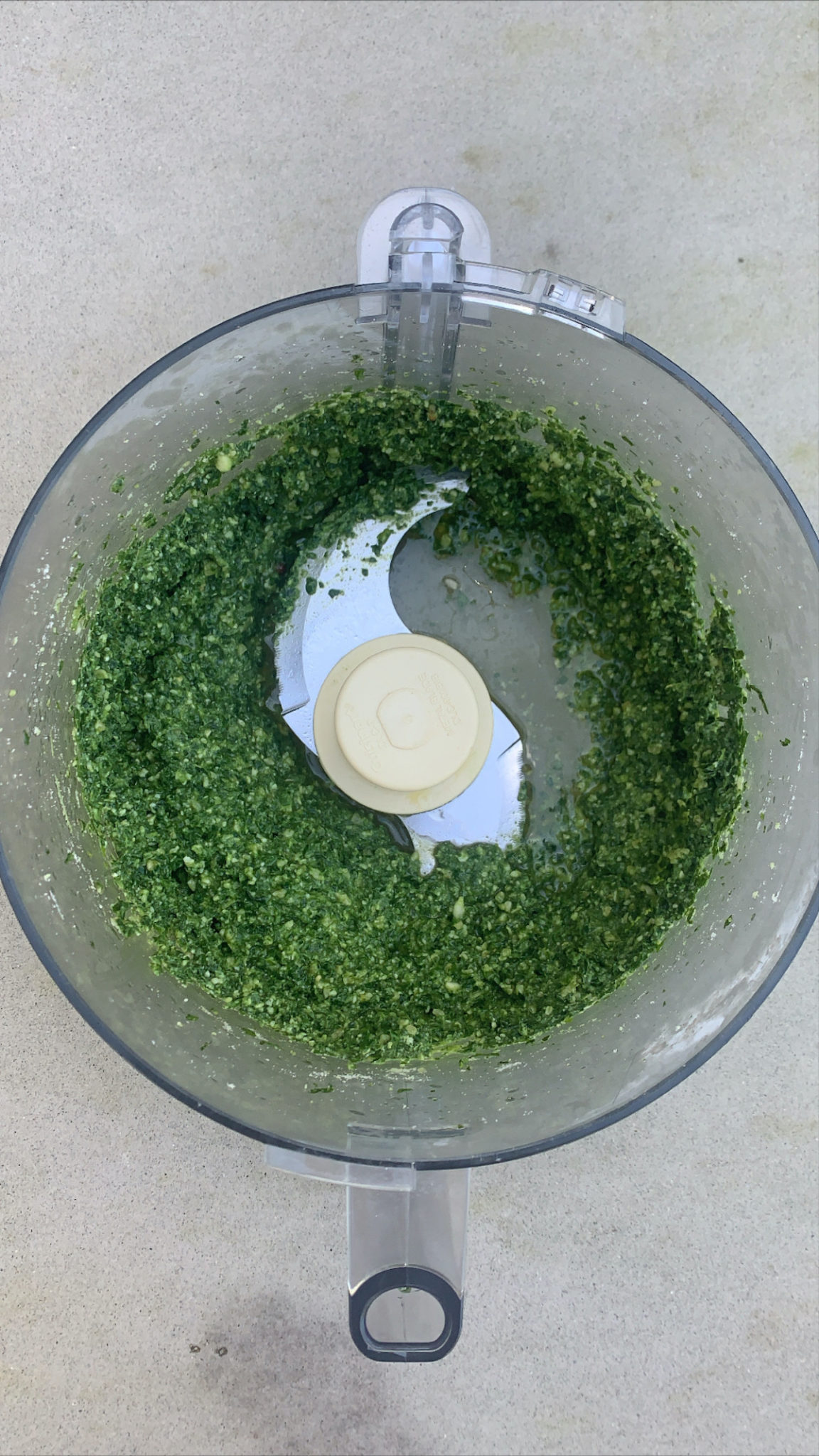
Use the proportions in this recipe along with the green garlic and any of the cooking greens from this week and last week’s boxes to make this pesto (arugula, spinach, Komatsuna leaves, turnip or radish greens).
Arugula (or spinach), Apple & Chickpea Salad Wraps
From The Kitchn
Photo by Emma Christensen
This recipe is from a set of 10 recipes at the Kitchn website decided to use up an abundance of spring greens. Spinach works well in these wraps, or you can also use arugula if you have some left from from last week’s box. The recipe provides instructions for dressing the greens and apple with a balsamic vinaigrette, but a creamy dressing made with green garlic, such as this one from Willy Street Co-op, would complement the other ingredients.
.
.
Vegetarian Chef’s Salad
From Cozy Peach Kitchen
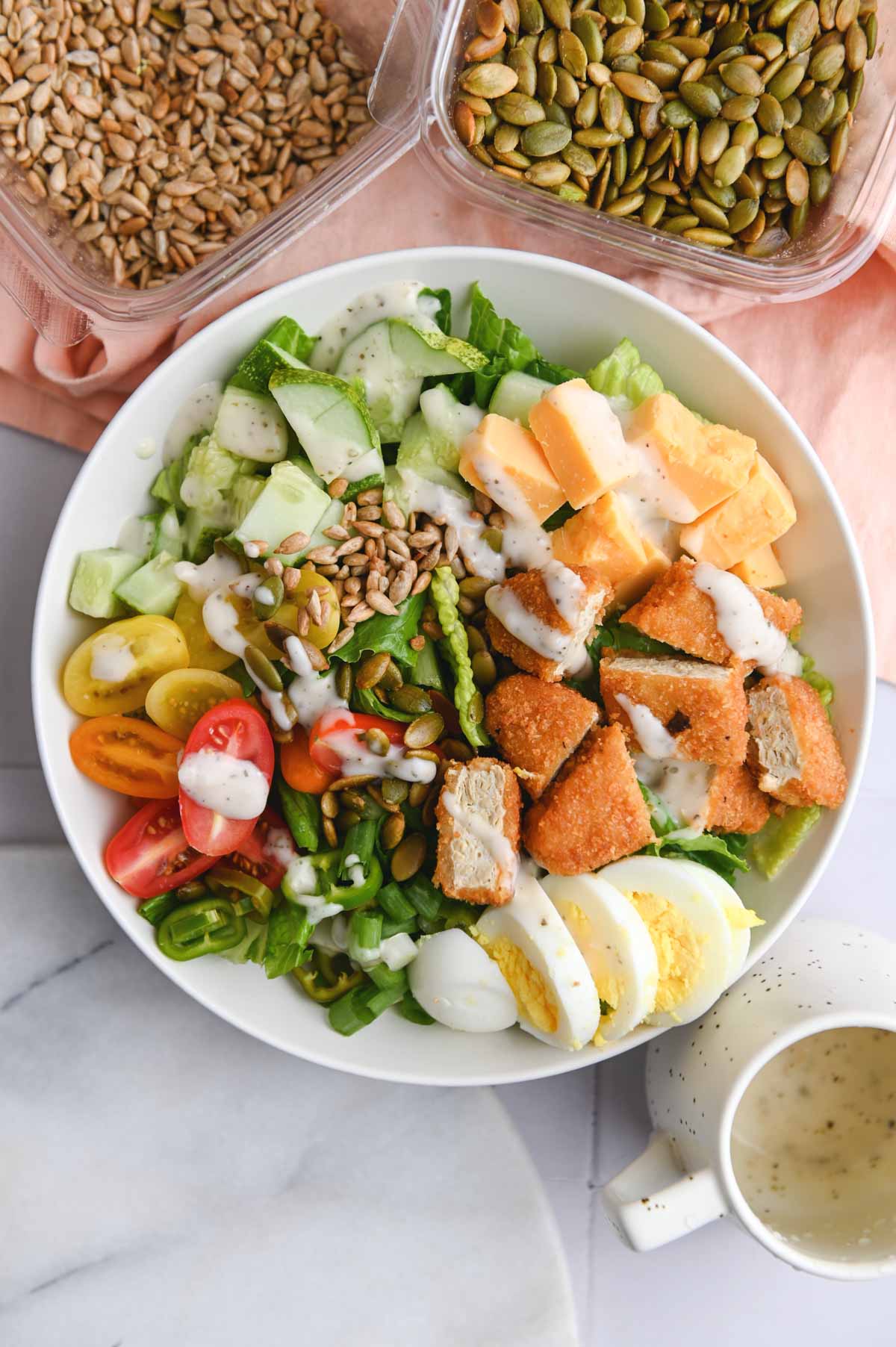
Here’s kid-friendly chef’s salad that replaces the traditional sliced turkey and ham with vegetarian chicken nuggets. You should feel free to sub chicken nuggets made from chicken, as well swapping ingredients we do not have, like romaine, cherry tomatoes, and cucumber, with vegetables we did get in this week’s box, like red leaf lettuce, steamed asparagus, lightly sauteed shiitakes, radishes, and salad turnips. There’s a recipe for vegan ranch dressing provided, or use creamy green garlic dressing.
Spring Share, Week #1, May 29
- On: May 28, 2025
 0
0
Deliveries begin this week (May 29) for these shares:
– Weekly Shares
– BiWeekly/ A group.
Deliveries next week (June 5) for:
– Weekly Shares
– BiWeekly/ B group.
If you don’t remember your share type, log in online and look at your scheduled dates under “Orders”.

Farm News


Transplanting melon seedlings into plastic mulch. The mulch suppresses weeds, conserves moisture, and improves melon quality. From left, Madelline, Aly, Ben and Maggie. Not in photo, Simone, Beth, Steve.
Our spring work progresses nicely. We’ve had a lot of beautiful, blue-sky days. It is pleasant working weather despite the swings in temperature. Some of your asparagus is short, some is long, the result of weather swinging hot – cold – hot – cold.
Our farm is quite dry. Many storms have missed us narrowly, raining a few miles away but missing us entirely. We watch the clouds and rain pass by on the horizon. It is a good thing we have irrigation.
We were relieved when one April storm passed us. Our town of Evansville was heavily hit by enormous hail. There was so much damage to cars, houses and roofs. Friends and neighbors are still arranging repairs and wrangling with their insurance companies. We could only imagine what it would have done to our spring crops, solar array, greenhouses, etc.

A hail stone that fell in Evansville WI this April. Photo credit Lisa Cromheecke James

From left, Steve, Ari, Beth, Sophie.
Ari graduated from Macalester College this spring. He is our youngest child, so this is a big milestone. He has a research position in mathematics lined for the summer, and is looking for a math-related job for fall in the Twin Cities. Most of you know Ari from the strawberry u-picks. He’s the tall guy showing you how and where to pick. We are very, very proud of this kid.
Strawberry forecast
The berry field looks great so far. There was only one frost during blossoming and we irrigated to protect the fragile flowers. There are many tiny berries on the plants. Keep your fingers crossed that they mature without trouble. They are delicate! We expect to begin picking berries in mid-June.
Let’s review the essentials of how our strawberry u-picks work.
– U-picks are by reservation only.
– I offer reservations first to our 2025 CSA members. Watch for emails from us with all the details, plus a link to place a reservation.
– If there are unclaimed reservation slots, I will offer them to our u-pick email list. After that, I’ll post publicly on Facebook. Honestly, it’s unlikely that we’ll get that far. Our organic berries are in high demand.
How to wash greens efficiently and to maximize storage life
Washing and drying your lettuce, spinach, and other greens prolongs their storage life. And they will be ready to use on busy weeknights! Here’s our approach. It works.
There will be grit in your produce this week, a side effect of recent rain and irrigation.
Thoughts:
– Cut your lettuce one and a half inches above the base and you’ll leave a lot of dirt behind.
– Expect to spend extra time cleaning this week’s greens. Let’s talk about how to do that efficiently.

Cut your lettuce heads at one and a half inches above the base and you’ll leave a lot of dirt behind.
1. Fill your sink or a basin halfway with cold tap water. If you have two sinks, fill one sink partway with cold water.
2. Chop your lettuce, spinach, escarole or other green to the size you wish.
3. Dump it into the water and swish around gently but thoroughly.
4. Working in two batches (for average lettuce head) or more batches (big spinach bunches, Romaine), pull handfuls out of the water and drain in the basket of a salad spinner.
5. After all the greens have been rinsed one time, dump the water. Rinse the sink/basin and refill with cold tap water.
6. Repeat the process.
7. Spin your greens dry and store in a dry container. They store much longer when spun dry.
This works because …
– pre-chopping the greens frees soil trapped in the head.
– the large amount of water washes and dilutes away the grit.
– By pulling the greens out of the water, you take advantage of the draining action to pull the grit with it.
– Drying (spinning) the greens before storage reduces spoilage.
Veggie List & Veggie Notes
Asparagus, 1 lb
Carrots, ~2.5 lb
Green leaf lettuce
Spinach, 1 bunch
Bok choy, 1 head
Arugula, 1 bunch
Salad radishes, 1 bunch
Green garlic, 1 bunch
Rhubarb, 1.5 lb
Next week’s box will probably contain asparagus, lettuce, spinach, leafy greens, radishes, green garlic and more.
ASPARAGUS – This is my favorite spring treat!
Prep: Wash your asparagus thoroughly to remove hidden grit. Submerge in water with the tips pointing down, soak briefly, then swish vigorously and pull out of the water. The draining action helps pull the grit out of the asparagus tips. Repeat several times.
Storage: Asparagus is perishable, so eat it as soon as possible. Store in a paper towel, cloth or paper bag, then wrap loosely in a plastic bag. The paper bag protects the asparagus tips from direct contact with the plastic bag. The plastic bag keeps the asparagus from wilting.
Preparation: We snap our asparagus at harvest, rather than cutting. Therefore, there is no need to snap the stalks to remove fibrous ends. For the same reason, it is not necessary to peel the asparagus stalks. It’s OK to trim the cut end a bit.
Cooking: If your asparagus stalks vary greatly in size, you will want to cook the thicker ones longer. Put an empty steamer pot over water, and bring the water to a boil. Add the asparagus. Cover and steam over medium heat until just tender. Use two forks or a spatula to turn the asparagus during cooking, rotating the bottom spears to the top. Drain and serve. Alternatively, you can lay spears flat in the bottom of a broad pan, with ½ inch of water. Also excellent broiled or grilled. Good dressed with vinaigrette, or with lime juice, salt and pepper.
CARROTS – These colorful carrots are from our excellent crop harvested in fall, then stored over the winter. You’ll get any two (or three!) of these colors: orange, purple, red, or yellow. Don’t be surprised to see small roots. They will rub off when you wash and/or peel your carrots.
Storage: Keep refrigerated! They want to grow!
GREEN LEAF LETTUCE – The lettuce very tender so handle gently.
Storage: Refrigerate in a bag or other container.
SPINACH – This spinach is good for salads or for cooking.
Storage: Refrigerate in a bag or other container.
BOK CHOY (rosette with thick white stems and green leaves) – This Asian green is good for stir-frying or sautéing or in soup. You can think of the stems and leaves as two separate vegetables. The stems require longer cooking. The leaves will cook almost as quickly as spinach. Bok choy stores well, so feel free to pull off leaves as you need them, or use the whole head at once.
Storage: Refrigerate in a plastic bag or other container.
ARUGULA – (bunch of green leaves with pungent scent) – This is a spring treat! Arugula is good mixed with lettuce or spinach in salads, or added to cooked dishes such as lasagne or quiche. I love it on sandwiches.
Storage: Refrigerate.
SALAD RADISHES – These are great in salads or thinly sliced on sandwiches.
Storage: Cover and refrigerate.
GREEN GARLIC (looks like scallions, tastes like garlic) – Last fall, we planted garlic cloves that grew into the stalks we harvested this week. If left to grow until mid-summer, the slim white bulb on this week’s garlic will divide and form the usual cluster of cloves in a garlic bulb.
Preparation: Green garlic is more pungent than scallions, so slice thinly and use sparingly when raw. It mellows when cooked. Chop and add to any cooked dish that would benefit from garlic. Use the white bulbs and pale green stems. Don’t use the dark green stems and leaves, as these are fibrous.
RHUBARB – Storage: Refrigerate in a plastic bag.
Stewed rhubarb: This is the simplest way to prepare rhubarb. Chop rhubarb into one inch chunks. Stir over medium heat with a small amount of water in the bottom of the pan. The rhubarb will release moisture as it cooks. Stew until it softens and falls apart. Sweeten to taste with honey or sugar. Eat warm on its own, over vanilla ice cream, on pancakes, etc.
Storage: Refrigerate.
Preserve: Rhubarb is extremely easy to freeze. Wash, chop and pop it in a freezer bag. That’s it; no need for blanching. When baking muffins or cakes, add the frozen rhubarb directly to the batter.
RECIPES from DEB
Rhubarb and Brown Sugar Skillet Pork Chops
From The Kitchn
This rhubarb sauce would also be delicious on boneless chicken breasts, that you could sauté using the same procedure as the pork chops. For a pinker sauce, you could omit the soy sauce – taste for salt – and sub white sugar or honey for the brown sugar.
.
.
Peppery Greens Salad with Avocado, Chicken, and Tortilla Croutons
By Justin Chapple for Food and Wine
:max_bytes(150000):strip_icc()/peppery-greens-salad-with-avocado-chicken-and-tortilla-croutons-FT-RECIPE0319-0be5ac06443c423e8146241b9498a644.jpg)
Here’s a main course salad recipe that you can make with a combination of the arugula, spinach, and lettuce from this week’s box, about 8 1/2 cups of greens all together. The recipe suggests toasting flour tortillas that have been brushed with oil directly on the rack in your oven. If you don’t want to risk a smoky mess, put the tortillas on a cooling rack placed on a cookie sheet to protect your oven! Broken, purchased, corn or pita chips would also work to add crunch to your salad.
.
.
Rhubarb-Walnut Quick Bread Recipe
From King Arthur Baking
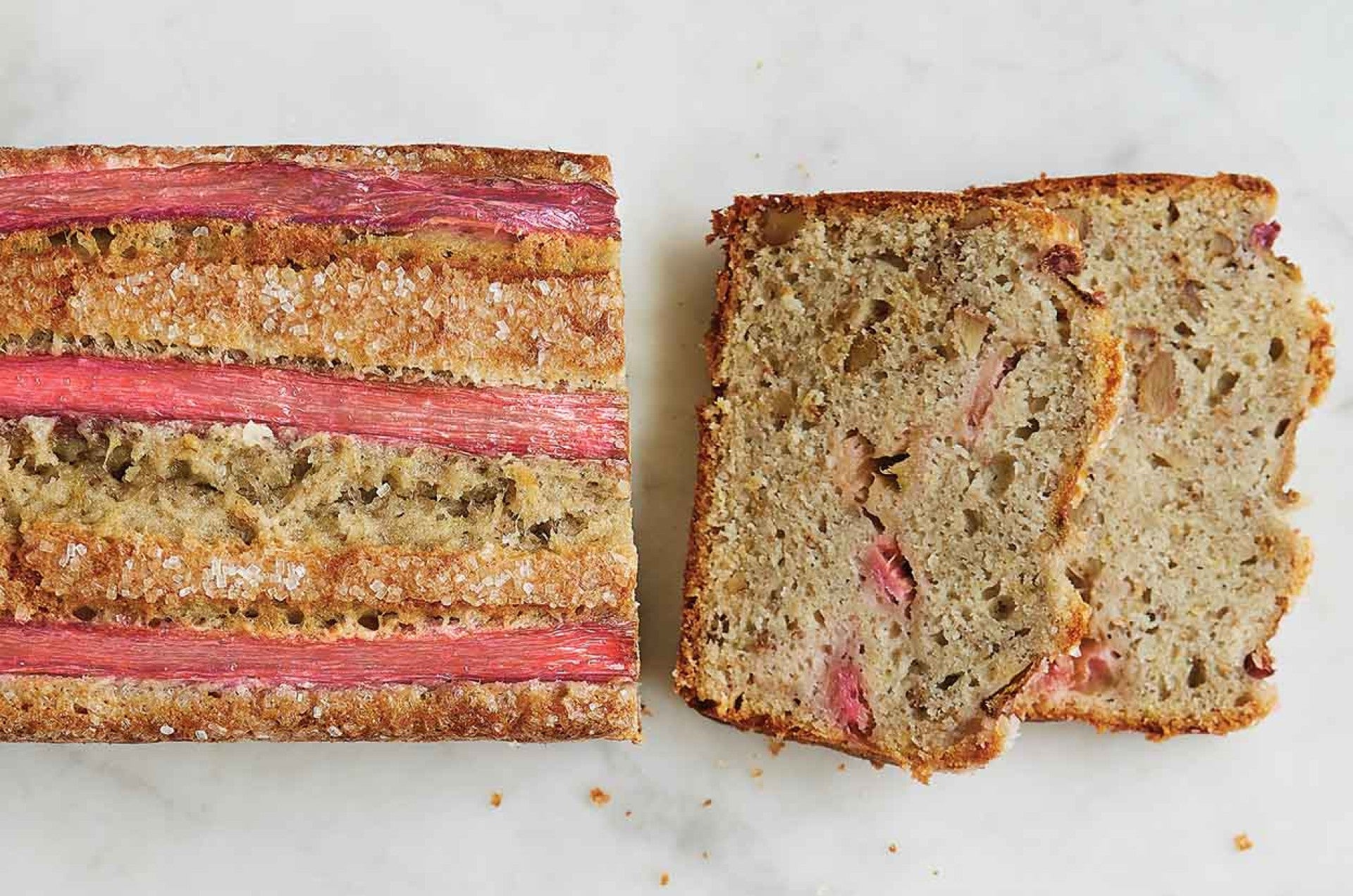
In this recipe the rhubarb is cooked briefly before being mixed into the bread batter, which improves the texture of the finished bread. Unless you have 3-4 very skinny stalks to decorate the top, I recommend splitting the stalks lengthwise.
.
.
Bok Choy and Radishes
From Taste of Home

I think we often forget that cooked radishes are tasty, and this simple, spring-y stirfry combining radishes and Bok Choy reminds us. The recipe calls for lemon-pepper seasoning, but if that’s not on your spice rack, regular black pepper alone or with some grated lemon zest or a squish of lemon juice will work just as well.
.
.
Carrot Tart
By Erin Merhar for The Pioneer Woman

Photo by Will Dickey
Roast the carrots from this week’s box and turn them into this elegant but easy tart with a purchased puff pastry crust. The recipe suggests using a soft garlic and herb cheese, such as Boursin, along with some grated Monterey Jack, but you could sub in other soft or grated cheeses depending on what you have on hand.
.
.
Spring Pasta with Peas and Asparagus
From Cookie and Kate

This recipe calls for a cup of fresh herbs, such as parsley and mint. Tossing in a combination of washed and roughly torn or chopped spinach and/or arugula leaves and sliced green garlic will add flavor in place of the herbs. I suggest adding the greens and garlic at the same time as the asparagus and peas.
.
.
Spicy Pork Bowls with Bok Choy & Broccoli
From Dishing Up the Dirt

Dishing Up the Dirt created this recipe for the transition season from summer to fall, but it works just as well in the transition from spring to summer! You can purchase broccoli to add to your bowls or use asparagus and arugula or spinach. Garnish with fresh radishes, and use sliced green garlic in the marinade. If you don’t eat pork, sub ground turkey or chicken, or crumbled tofu for vegetarians.
.
.
Pop-Up CSA box, Friday October 4
- On: October 03, 2024
 0
0


Thank you all for signing up for this one-time delivery. Our produce is abundant right now and we are pleased to share with all of you! The farm is beautiful this fall. We are irrigating, because we must, but the dry, sunny weather is healthy for our crops.
Veggie List & Veggie Notes
October 4, 2024
Autumn Frost winter squash
Carrots, 2lb
Bok choy
Leeks, 1 or 2
Bell peppers, a mix of colors and #1 & #2 grades
Oranos snack peppers, 1.75 lb
Jalapeno chile (in the bag of Oranos), 1
Daikon radish, ~2 lb total
Basil, 1 small bunch
‘Autumn Frost’ squash – Store cool and dry. 60 F is ideal.
This beautiful frosted squash has both pumpkin and butternut squash breeding. They cook and taste like an unusually good butternut, with rich, smooth texture. This is a fairly new variety. The breeders really knocked it out of the park with this one. The skin is edible.
Carrots – The first harvest of fall carrots!
Storage: Refrigerate.
Bok choy (rosette with thick white stems and green leaves) – This Asian green is good for stir-frying or sautéing or in soup. You can think of the stems and leaves as two separate vegetables. The stems require longer cooking. The leaves will cook almost as quickly as spinach. Bok choy stores well, so feel free to pull off leaves as you need them, or use the whole head at once.
Storage: Refrigerate in a plastic bag or other container.
Leeks (look like big scallions) – These alliums have a milder flavor than onions. Nonetheless, they can be used in recipes that call for onions. To wash, split the leek lengthwise, from the green tops about halfway to the base, leaving the base intact. Rinse well under running water, separating the layers to flush. If necessary, split the leek further if soil has penetrated more than halfway down the leek. Shake dry. Leeks are generally eaten cooked. They can be sauteed, steamed or roasted. Intact leeks will store 2 to 3 weeks if covered loosely and refrigerated. The outer leaves will yellow. Just peel them off and discard. The inner leek layers will be fine.
Bell peppers – We are sending a mix of #1 and #2 grade bell peppers. All are ripe and delicious. Examine your peppers. Use any with flaws first.
Storage: Refrigerate.
Korean radishes – These are a favorite vegetable among our farm crew. Crunchy Korean radishes are sweeter and milder than Japanese daikon radishes and come in a more manageable size. They contain lots of water, which makes them easy to pickle or ferment. You’ll receive at least two of the colors we grow: white, red and purple.
Storage: Refrigerate.
Basil – This batch is very fragrant. We harvested on a windy day. If your basil looks wilted, submerge in room temperature water for five minutes.
Storage: Trim the stem ends. Store at room temperature in a jar of clean water, like a flower bouquet. Chop finely, mix with olive oil and freeze for winter.

Your jalapeño chile will be in the bag of sweet Oranos peppers. Oranos are orange or orange & green. The jalapeño will be green, red, or green & red.
RECIPE IDEAS from BETH
Let’s brainstorm Oranos snack peppers
We love these flavor bombs and are sending a generous bag. Here are some ideas.
The perfect lunchbox snack
You could eat every one as a snacks – they are perfect in a lunchbox. Pack them whole or de-seed, cut in half and smear with a dollop of goat cheese.

Pickled peppers
You can pickle any type of pepper but Oranos are especially beautiful. Here’s my method.
Snack peppers, about 3 or 4 peppers per pint
Garlic, 1 crushed clove
Brine (enough for one packed quart jar):
Water, 2 cups
White vinegar, 3 Tbsp
Salt, 1.5 Tbsp
1. Mix the brine ingredients and stir at room temperature to dissolve.
2. Clean a pint or quart jar.
3. Slice your peppers in strips. Pack into the clean jar. Break the crushed garlic clove into a few pieces and tuck into the jar.
4. Pour brine to the top. Seal with a lid. Slowly rotate to let bubbles escape to the top.
5. Refrigerate for one day before eating.
.
.

Appetizers / Charcuterie plate
Google ‘appetizer snack peppers’ for a wealth of options. Sliced Oranos are great for dipping in hummus or cheese dip. Add some sliced carrots, red peppers, and daikon to the plate for crunch and beauty.
Korean radish

You will receive at least two of the daikon colors we grew this year; white, red and purple.
This is a favorite vegetable among our farm crew. These crunchy Korean radishes are sweeter and milder than Japanese daikon radishes and come in a more manageable size. They contain lots of water, which makes them easy to pickle or ferment.
Here are some of my favorite uses.

Clockwise from top; Vietnamese Pickled Carrots & Daikon Radish Recipe (Đồ Chua, photo credit Hungry Huy); the Maangchi.com website has so many recipes for Korean daikon including Radish Kimchi (photo credit Maangchi).
Vietnamese Pickled Carrots & Daikon Radish Recipe (Đồ Chua)
From Hungy Huy.
This is my go-to recipe for mixed daikon-carrot salad. The recipe calls for a light fermentation but it’s good after an hour in the fridge. This pickled carrot-daikon salad is used to top bahn mi sandwiches and in other Vietnamese dishes. Huy offers a nice discussion of how this pickle evolved as his family emigrated to the US. He lists these other recipes that the pickles can be used with:
Vietnamese sandwiches (bánh mì), savory crepes (bánh xèo), grilled pork and noodles (bún thịt nướng), egg rolls (chả gìo), and the list goes on. Larger cuts are usually found next to cuts of meat, while finer shreds are put in nước chấm (dipping sauce).
Maangchi rules for radish ideas!
Head to Maangchi for dozens of radish recipes. She has the best website for Korean recipes. Her Radish Kimchi recipe is close to foolproof and easy to scale.
The Oriental Food Mart on Park Street in Madison is a Korean grocery that stocks Korean hot pepper flakes called for in many of her recipes. Ask the owner for help picking out your pepper flakes – he is super helpful. I keep a bag of medium heat in our freezer and use them in everything for flavor without excessive heat.
Week #4. Final box of June Share.
- On: June 26, 2024
 1
1
This delivery wraps up our June Share.
We hope you enjoyed our experimental 4-week June Share. We think it went quite well. I like that we were able to include most everyone’s spring favorites. At this point, let’s assume we will do this again next year. Watch for emails over the winter.
What’s next?
Our next farm offering will be organic plum (Roma) tomatoes, for sauce, freezing or canning. The tomatoes are often ready around the Labor Day weekend.
– We plan to host on-farm u-picks so you can come harvest ripe plum tomatoes.
– We might offer pre-picked plum tomatoes for sale as well.
I’ll send emails to all of June Share members plus everyone on our email list.
I might offer a pop-up sale in fall, something similar to a CSA box or a smaller version of our Storage Share from other years. Just watch for emails from me.
Willy Street Coop and Outpost Natural Foods and Basics Coop will stock our produce through the summer, fall and winter. Next week, we begin planting carrots for those 5 lb bags to deliver all winter! Now we just need a dry spell to get the carrot seeds in the ground.
Strawberry Wrap-Up

There were a lot of berries ready to pick!
Our berry season came to a dramatic end during the u-pick on Saturday. People came at 9:00am, hustled and hurried home with lots of berries. The picking was good until the downpour. But you all are tough and everyone was in a good mood once the rain stopped again. However, the heavy rain on Saturday … and Saturday night … and Monday night have damaged the berries. Our berry season is finished. We hoped to pick for this week’s delivery but the berries are gone. Instead, we put that picking time into sugar snap peas and have an astonishing 1.75 lb for each box! I do not think we’ve ever delivered that many peas at once.
Thank you all so much for joining our June Share this year. We are honored by the trust you have in us. Please enjoy this last delivery.
Beth & Steve
Veggie List & Veggie Notes
Week #4, June 27, 2024
– Weekly shares
– BiWeekly/ B group
Sugar snap peas, ~1.75 lb
Napa cabbage
Zucchini &/or summer squash, ~3 lb
Cucumbers, ~3
Silver Slicer cucumber, 1 or 2
Kohlrabi, 1 or 2
Scallions, 1 bunch
Basil, 1 sprig
Rhubarb, 1.25 lb
Sugar snap peas. These peas should be eaten pod and all. They are delicious raw, or very lightly cooked or stir-fried.
Preparation: They will need a quick rinse to remove faded gray blossoms. Here’s how to remove the strings on each pod. Snap off the stem end and pull the string down the concave side of the pod (the inward-curing side). Throw away the string and eat the pod. The thicker pea pods will usually have a string along both edges. Remove them when you snap off the stem.
Storage: Refrigerate.
Napa cabbage (large, pale green cabbage with crinkled leaves) – Napa cabbage is an interesting vegetable, useful for both fresh, raw salads and for cooking. Its most famous use is fermented kimchi. I like to prepare a fresh, unfermented kimchi. Same seasonings, but it’s ready to eat right away. You will be amazed at how much shredded napa cabbage shrinks when prepared this way. See here for an example, but cut the salt in half (or even further): Grilled Flank Steak with Kimchi-style Coleslaw.
Storage: Napa stores very well. When refrigerated, it will keep for several weeks. Peel off the outer layer and it will be ready to use. Here are a few preparation ideas from the ‘Asparagus to Zucchini’ cookbook.
– Chop raw napa into green salads.
– Substitute napa in traditional coleslaw.
– Chinese cabbage cooks quickly. Steam 3-5 minutes, or until leaves are wilted down but remain slightly crisp.
– Substitute napa cabbage for common cabbage in recipes, but reduce the cooking time by 2 minutes.
– Napa cabbage is the main ingredient in egg rolls. Try making an egg roll mixture to eat as a cooked side dish instead of preparing time-consuming egg rolls.
Zucchini & summer squash – Zucchini and summer squash need refrigeration but do not do well at very cold temperatures, as they will soften and form pits in their surface. Refrigerate these squash but in the warmest part of your fridge.
Cucumbers – We have been waiting for these! You’ll receive green slicing cukes or a white variety called Silver Slicer. These smaller cucumbers are thin-skinned, like pickling cucumbers, with delicious flavor. No need to peel the Sliver Slicers. For that matter, there’s no need to peel the green cucumbers either, unless you receive an unusually large one.
Storage: Store at room temperature for a few days or refrigerate in the warmest part of your fridge. Cucumbers get chilling injury if stored too cold.
Kohlrabi (pale green, round vegetable with thick skin and attached leaves) – Crunchy and sweet, kohlrabi is a great addition to salads.
Storage: Kohlrabi bulbs will store for a month in the refrigerator. Remove the leaves if you plan to store for more than a few days.
Uses: Kohlrabi are good peeled and eaten out of hand, or added to sandwiches, or added to salads. It makes a nice salad on it’s own. You can grate it, slice it, or cut it into matchsticks. It’s also good cooked.
Basil – The basil is very tender so we washed them very gently. Expect to wash again to remove grit. For this harvest, we cut entire plants. It is lovely stuff.

Green slicing cucumbers and a Silver Slicer cucumber.
RECIPES by DEB

Photo credit Christopher Testani
Spicy Skillet Ground Turkey and Snap Peas
From the New York Times
Combine the sugar snaps and scallions in this week’s box with ground turkey to make this spicy stirfry, and you can add more fresh basil if you don’t have mint – or simply omit the mint.
.
.

Photo credit Sidewalk Shoes
Pasta Primavera with Shrimp and Sugar Snap Peas
From Sidewalk Shoes
In addition to sugar snap peas, scallions, and the basil that you will find in this week’s box, this recipe also calls for fresh parsley and arugula. But Primavera recipes are forgiving in terms of what veggies you use, so you can sub in what you have and certainly amping up the amount of sugar snaps will work just fine. The images in the post show snow peas rather than sugar snaps, but they’re pretty interchangeable too! And 3 cups of dry penne (or other pasta) is about 12 oz. or 3/4 of a pound.
.
.

Photo credit Leah Maroney
Pickled Kohlrabi
From The Spruce Eats
These kohlrabi pickles will keep in the back of the fridge for a long time and can be served as a condiment with hamburgers or brats, or any other sandwiches. The recipe also suggests chopping them up for coleslaw and adding some of the brine to the dressing, or serving them as a garnish in your martini!
.
.

Photo credit Kellie Hatcher
Crunchy Napa Slaw
From Mountain Mama Cooks
This crunchy slaw will put a good dent in the Napa cabbage in this week’s box, and also calls for sugar snaps and scallions. You can sub in the basil for cilantro and julienned or grated kohlrabi could stand in for carrots.
.
.

Photo credit Molly Yeh
Magic Sesame Sauce
From Molly Yeh, My Name Is Yeh (“yay”)
This week’s box contents, and the weather, suggest cold spicy noodle salads. If you’re like me, you’ve tried a ton of cold peanut and/or sesame noodle recipes – and there are plenty of them out there online! – but this simple sauce from food blogger and TV cooking show personality Molly Yeh is really simple and dependable. You can make it with either tahini or peanut butter and it’s enough sauce for 8 ounces of noodles. It can also easily be doubled, and can be topped with torn fresh basil, scallions, zoodle-ized zucchini, or thinly sliced cucumbers, as just a few possibilities.
.
.

Photo credit Justine Doiron
Zucchini Muffins with Cinnamon Chocolate
From Justine Snacks
Zucchini season has come early this year, and this muffin recipe deserves a try. It has just enough chocolate and it’s not too sweet, and the muffins keep well and seem to actually taste better after a few days. The recipe is written for 6 jumbo muffins, and does provide measurements for making regular size. I made regular size muffins and got 13, and didn’t have any of the cinnamon chocolate left for the topping, so if topping is important to you, made some extra!
.
.
A couple of go-to recipes for 3+ pounds of zucchini

Photo credit James Ransom Food52
Best Zucchini Butter Recipe – How to Make Jennie Cook’s Zucchini Butter
From Food52
There are quite a few versions of zucchini butter out there and it is sometimes attributed to Julia Child. Wherever the recipe came from it’s a versatile way to preserve zucchini. I don’t even drain and squeeze the grated zucchini, because the extra juice will reduce in cooking and make the butter more flavorful. Zucchini butter can be made dairy free, and is great in eggs, on toast, and can be frozen. Many people’s favorite way to use it is in smitten kitchen’s zucchini butter spaghetti.
.
.

Photo credit RecipeTin Eats
Zucchini Tian
From RecipeTin Eats
Here’s a nicely laid out version of a classic Julia Child recipe, Tian de Courgettes au Riz (Zucchini Tian). This is another recipe with many versions online, for example smitten kitchen or DebsLunch, but I find this one from RecipeTin Eats easy to follow.
Week #3. Farm News.
- On: June 19, 2024
 0
0

We have two boxes of strawberries for everyone this week.
Farm news
Wow, that was a burst of heat and wind this week. Most of our crops love the heat. It’s striking how much the zucchini plants grew. We were surprised to have zucchini in your June 13 boxes, just as we were surprised to have strawberries for you on June 6. It was an early spring but now crops are settling into their usual schedules.
There was a three-week rainy spell in May and June, totalling 7.5 inches here at our farm. That is as much rain as we got last year in all of April, May, June, July, August and September combined. What a striking difference. Seven and half inches is a lot for three weeks. Less than 7.5 inches in six months is extraordinary. So we are not complaining about rain this year.
Strawberries dominate our life right now. The four u-picks we hosted have been fun but time-consuming. We spend a lot of time in the fields judging which varieties are ready to pick, then strategizing harvests and u-picks.
We are thrilled to have two pounds for you this week. The crew groaned when they learned that we needed 94 pails of berries but then I showed them the field section ready for harvest. It was great picking.
Final berry u-pick?
Saturday June 22. Reservations required.
This is probably our last berry u-pick of the season. I will post the reservation link here in this blog and here once I am ready to open reservations to the public. Tipi CSA members, I sent you the June 22 link via email, earlier today.
Thanks,
Beth
Farm photos


It takes a team to pick your berries. From left at top, Ari, Maggie, Aly, Ben, Ava and Madelline. Not in photo, Simone and me.

How’s that for a pretty field? Three beds of zucchini and Zephyr summer squash, plus two beds cucumbers at left. These will be harvested for next week’s CSA box, then for Willy Street Coop and Outpost Natural Foods Coops.
Veggie List & Veggie Notes
Week #3, June 20, 2024
– Weekly shares
– BiWeekly/ A group
Strawberries, 2 lb
Lacinato kale
Zucchini &/or summer squash, ~3lb
Fennel, 1 bulb with fronds
Red bibb lettuce
White salad turnips (just roots, no tops)
Scallions
Garlic scapes, a handful
Next week’s box will probably contain snap peas, napa cabbage, zucchini, scallions, basil and more.
Strawberries – The berries are coming on strong! As usual, they are perishable so refrigerate and enjoy soon.
Lacinato kale (bundle of grey-green textured leaves) – This is our most beautiful cooking green and a super food! Use like any kale.
Storage: Cover and refrigerate.
Zucchini & summer squash – The plants love heat and have really taken off.
Storage: Zucchini and summer squash need refrigeration but do not do well at very cold temperatures, as they will soften and form pits in their surface. Refrigerate these squash but in the warmest part of your fridge.
Fennel (bulbs and lacy fronds) – Fennel is a ‘swing vegetable’; it can be used raw or cooked. Clean well and slice as thinly as possible for use in raw salads. It is good simply prepared with olive oil, lime or lemon juice, salt and shaved parmesan cheese. Cooking softens and sweetens fennel, and mellows its anise flavor. Both the bulb and leaves are edible. Here are ideas from Alice Waters of Chez Panisse about how to use fennel: ‘It’s strong anise characteristic seems to suit fish particularly well. … We use fennel all the time. We add the feathery leaves to marinades for fish and to numerous salads, sauces and soups and we use them as a garnish, too. … The bulbs are sliced and served raw in salads in various combinations with other vegetables, parboiled for pastas; caramelized and served as a side dish; braised whole; or cooked in vegetable broths & fish stocks.”
White salad turnips – We are sending just the white roots this time. The tops had too much insect damage so we cut them off.
Scallions (bundle of green onions) – These are useful raw or cooked. Thinly-sliced raw scallions can be folded into biscuit dough or sprinkled on top of soups or salads. Terrific garnish for pasta dishes. Think pad thai.
Garlic scapes (curly green things) – Garlic scapes grow at the top of garlic plants. We snap off the young scapes to direct the plants’ energy into forming garlic bulbs underground. Use scapes as a substitute for garlic cloves. They can be minced, mixed with olive oil, and added to stir fries or simple pasta dishes. The scapes can be sautéed, but will not brown like garlic cloves. Expect them to retain their crunch even when cooked, and to be milder than garlic cloves, closer in pungency to the green garlic we’ve sent.
RECIPES by DEB
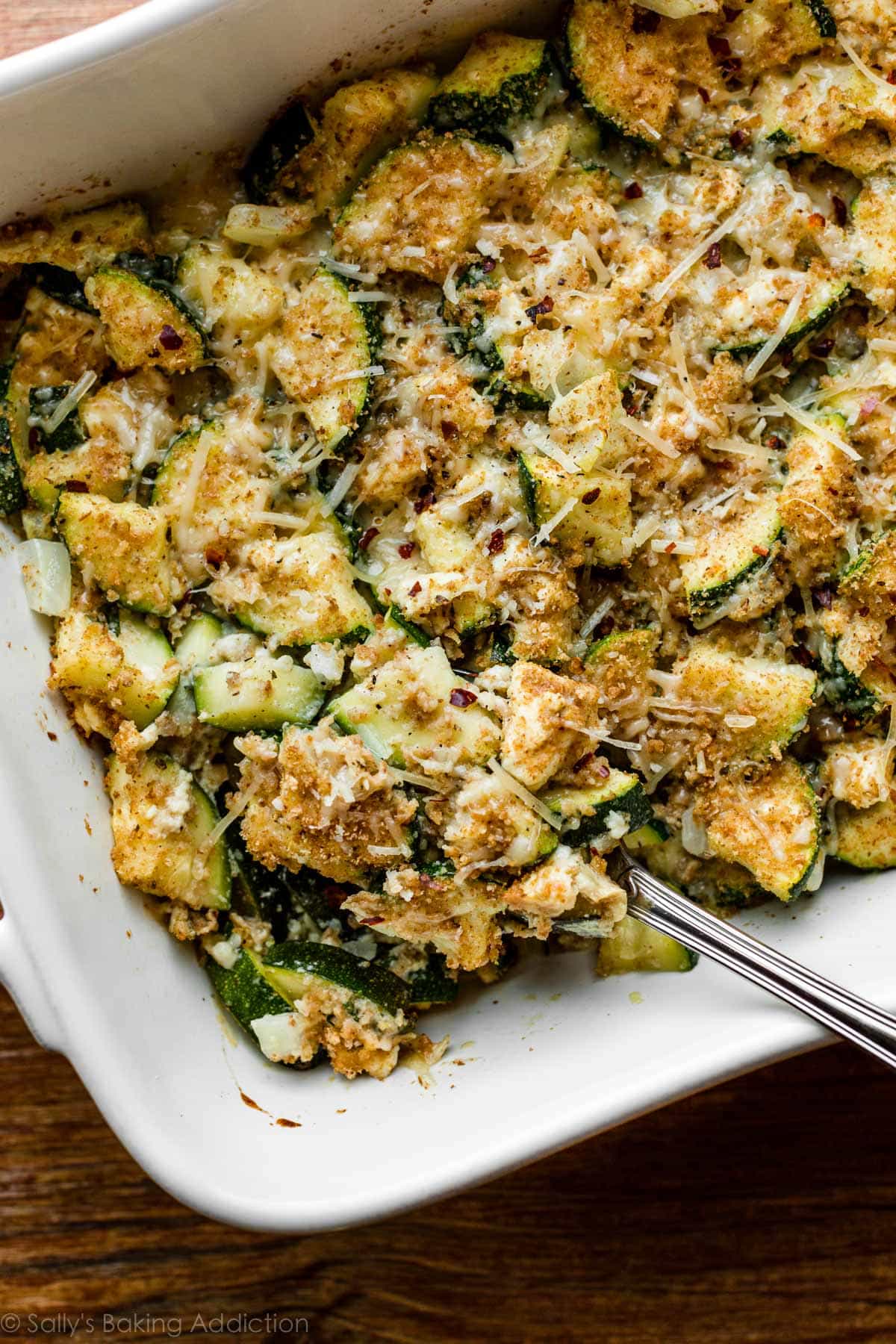
Photo credit: Sally’s Baking Addiction.
Zucchini Casserole
From Sally’s Baking Addiction
I’ve tended to turn to the Sally’s Baking Addiction website for sweet baked good, but here’s a savory, substantial recipe for zucchini, and of course once you’re at the site, you can follow links to sweet zucchini muffins and bread, etc. You can use either fresh or dried herbs in the casserole.
.
.
Photo credit: Lucy Schaeffer; Food Styling Debbie Wee
Strawberry Icebox Cake Recipe
From The Kitchn
Here’s a fun no-bake dessert for these hot days. The recipe calls for 2 pounds of strawberries, but if you’d like to reserve some of this week’s strawberry haul for plain eating, I tested it as a half-batch in an 8×8 pan. You’ll only need one pound of strawberries and 1 3/4 cups heavy cream. I left off the chocolate, too.
.
.
Here are two options for fennel salads: the first is mainly fennel, the 2nd includes zucchini and greens.
Fennel Salad
From RecipeTin Eats
This shaved fennel salad is, as the author says, quick and easy to make if you have a mandolin. If you don’t, a sharp knife will do it, or the slicing blade of a food processor. There are only 5 ingredients in this salad, fennel, lemon, olive oil, onion, and Parmesan. If you’d like a salad with less focus on the fennel, see the next recipe.
.
.
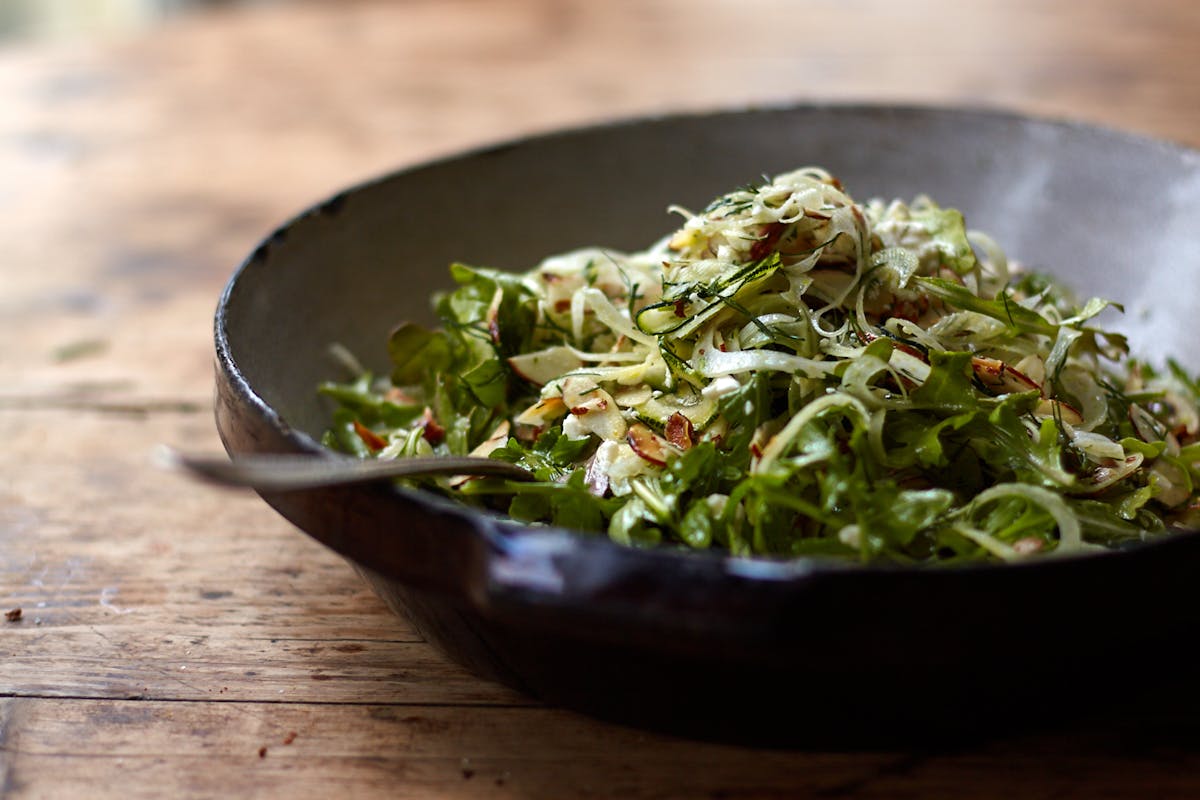 Photo by Heidi Swanson
Photo by Heidi Swanson
Shaved Fennel Salad
From 101 Cookbooks
This fennel salad is from a cookbook titled Super Natural Everyday and made available online at 101 Cookbooks by the author, Heidi Swanson, and it was also in a late June newsletter from last year. It features fennel and zucchini, two of the vegetables we have in this week’s boxes, and is served over arugula, but you can certainly sub the Red Bibb lettuce instead.
.
.

Photo by Susanality
Zucchini Baba Ganoush
By Susan Spungen, From Susanality
This recipe uses zucchini in place of eggplant to make Baba Ganoush, an idea that’s new to me, but looks like a great way to use up an abundance of zucchini. The recipe provides suggestions for charring the zucchini using a gas grill, your oven’s broiler, or charcoal, especially if you’re grilling something else.
.
.
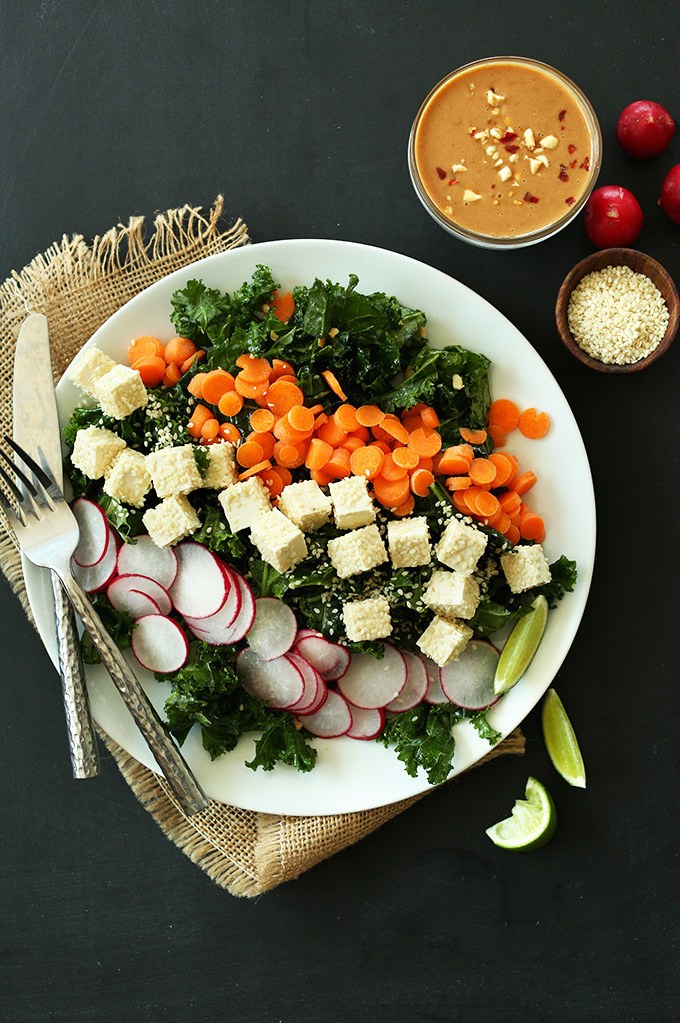
Photo credit: Minimalist Baker
Thai Kale Salad
From Minimalist Baker
Lacinto kale is great in salads since it’s usually more tender than other varieties, and this recipe gives it a nice twist with a Thai style peanut dressing. The salad is topped with raw tofu that’s been tossed in sesame seeds, and provides instructions for roasting the tofu if you prefer your tofu cooked. Thinly sliced salad turnips would be a good substitution for the carrots and radishes in the salad. And if you’d rather prepare the kale as a Caesar salad, the tahini Caesar salad dressing in last week’s newsletter would work great on kale.
.
.
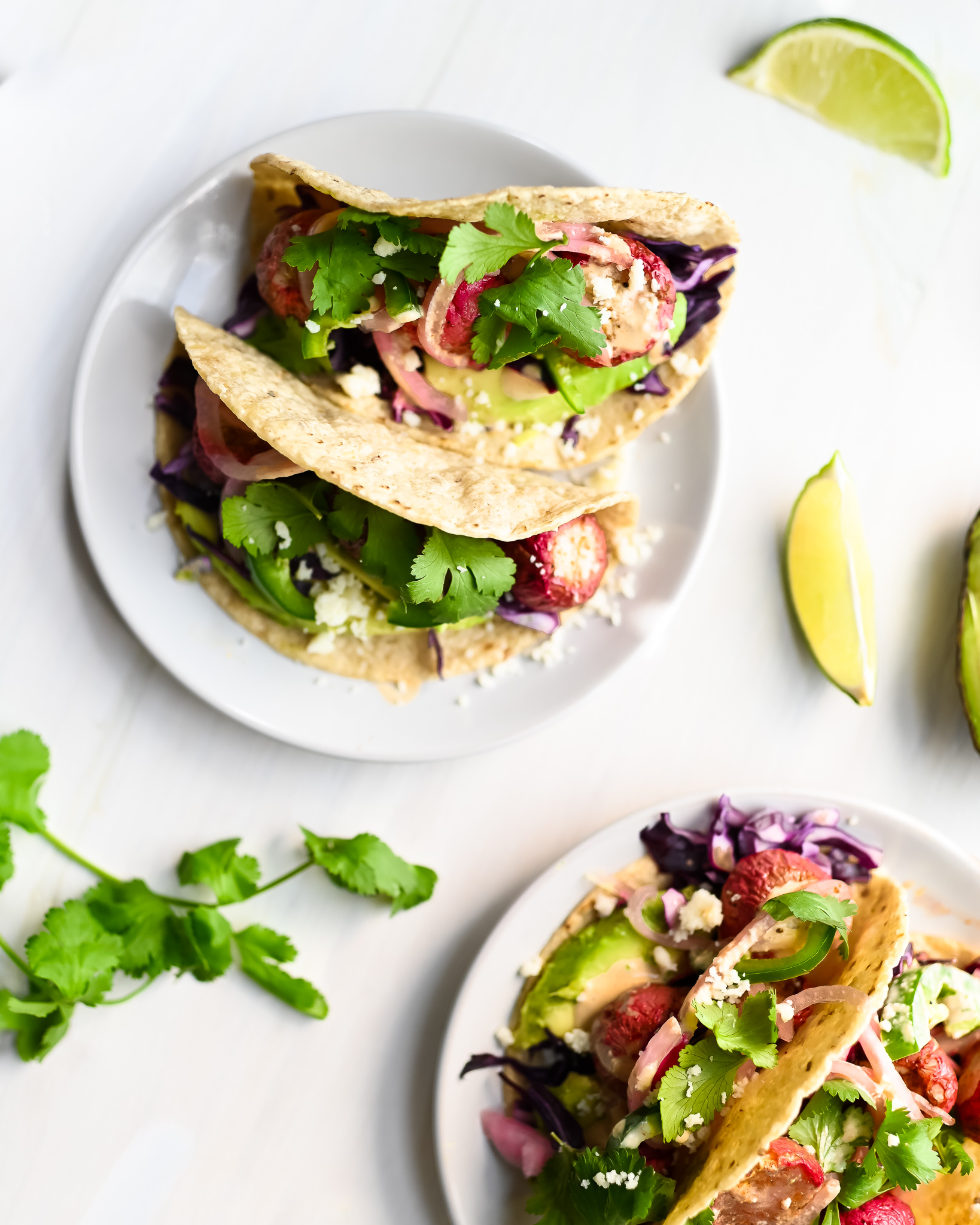
Photo credit: The New New England
Roasted Radish Tacos with Spicy Lime Sauce
From The New New England
OK, you might be wondering why a recipe for radish tacos is included this week, and it’s because the basic principle of the recipe is to roast early summer vegetables and use them for taco filling, and there are a couple of ways to sub in the veggies we have in this week’s box. One method would be to roast chunked salad turnips in place of the radishes (they’re similar in water content) and proceed with the recipe. Another method would be to roast zucchini cubes in place of the radishes and shred salad turnips to top your tacos in place of the cabbage called for in the recipe. The recipe also strongly recommends a brand of corn tortillas that I have never tried – they do seem to be widely available if you’d like to give them a try.
Week #2. Weekly + BW/B. Berry U-Picks.
- On: June 13, 2024
 0
0
U-Picks by reservation
The berries are doing great! We will host several berry u-picks in the next few days. Reservations are required. Tipi members, check my email for links to reserve a picking time. Everyone else, join our email list so we can send you the reservation links.
Grit, grit, grit
This week’s produce has seen a lot of rain over the last month. The Romaine and asparagus need washing to get rid of grit. See last week’s notes about how to wash your greens efficiently.

Cut your lettuce heads at one and a half inches above the base, then discard the base. In one stroke, you’ll eliminate a lot of dirt behind.
Veggie List & Veggie Notes
Week #2, June 13, 2024
– Weekly shares
– BiWeekly/ B group
Strawberries, 1 lb
Asparagus, 1.25 lb
Button mushrooms, 12 oz
Zucchini or yellow squash, 2 or 3 ct
Romaine lettuce
Spinach, 1 bunch
Mixed red & green kale, 1 bunch
White salad turnips, 1 bunch
Green garlic, 1 bunch
Next week’s box will probably contain strawberries, lettuce, white salad turnips, zucchini, cooking greens, scallions and more.
Strawberries – The berries are doing great this week, soaking up the sunshine.
Storage: Refrigerate and eat soon.
Asparagus – This is the final harvest. Enjoy!
Button mushrooms – These organic mushrooms are from Hidden Valley Mushrooms from Wisconsin Dells. We bring in mushrooms from Mary and Ed every spring because they combine so perfectly with our spring vegetables, for salads, quiches, etc.
Storage: Here are Mary’s suggestions for storing the mushrooms:
– Store separate from leafy greens, which hasten mushroom aging.
– If storing for more than a few days, remove from the box and refrigerate in a paper bag with holes punched in the side. Keep dry.
– Don’t wash to clean, just wipe with a damp cloth.
Spinach – This batch will be best cooked.
Kale – We’re sending mixed bunches of red and green leaves this time, just because they are pretty.
Storage: Cover and refrigerate.
White salad turnips (see photo) – I know that returning members look forward to these sweet and delicious turnips, which taste nothing like the turnips that are harvested in fall.
– Storage: Cover and refrigerate.
– Uses: Both the turnip roots and tops are edible. The roots are excellent raw; Slice and add to salads. They can be cooked and are especially good when lightly sauteed in butter. Stir as little as possible so they brown on at least one side. The turnips greens are excellent cooked. Treat them like mustard greens.
– Our favorite use: Slice the roots very thinly and combine with a mixture of rice vinegar, mirin, soy sauce, sesame oil. Eat immediately or marinate.
Zucchini – We have the first harvest already. This is early!
Storage: Cover and refrigerate.
RECIPES by DEB
Crunchy Celery, Radish and Turnip Salad-Slaw in Blue Cheese Sauce
From Food52
If you have radishes left from last week you could add them to this salad, or simply omit – and if you do that, you might have extra blue cheese sauce, which could be a good thing, because it would be tasty on other salads!
.
.

Tahini Caesar Salad with Olive Oil Breadcrumbs
From Familystyle Food
I love crunchy home made croutons in a salad, but recently I’ve been finding that toasty breadcrumbs are also a great way to top a salad, especially one with a creamy dressing like this. The recipe’s method of essentially making croutons first and then crumbling them to make the breadcrumbs sounds messy to me. Alternatively, you could make the crumbs first in a food processor – or purchase – and then brown the crumbs in the olive oil in a skillet. And throw a little garlic or green garlic in as the crumbs toast!
.
.

Bucatini with Sausage & Kale
From Taste of Home
This recipe is a version of a common combination for pasta: some kind of greens, sausage, and cheese. Some recipes also include heavy cream, unlike this one, making this version healthier! But if you are in a mood to indulge, you could add 1/4 to 1/2 cups cream when the sausage is browned. Bucatini is like fat, hollow spaghetti, so a different long noodle like spaghetti or linguini or fettuccine would work here, or you could also use a short pasta like penne.
.
.
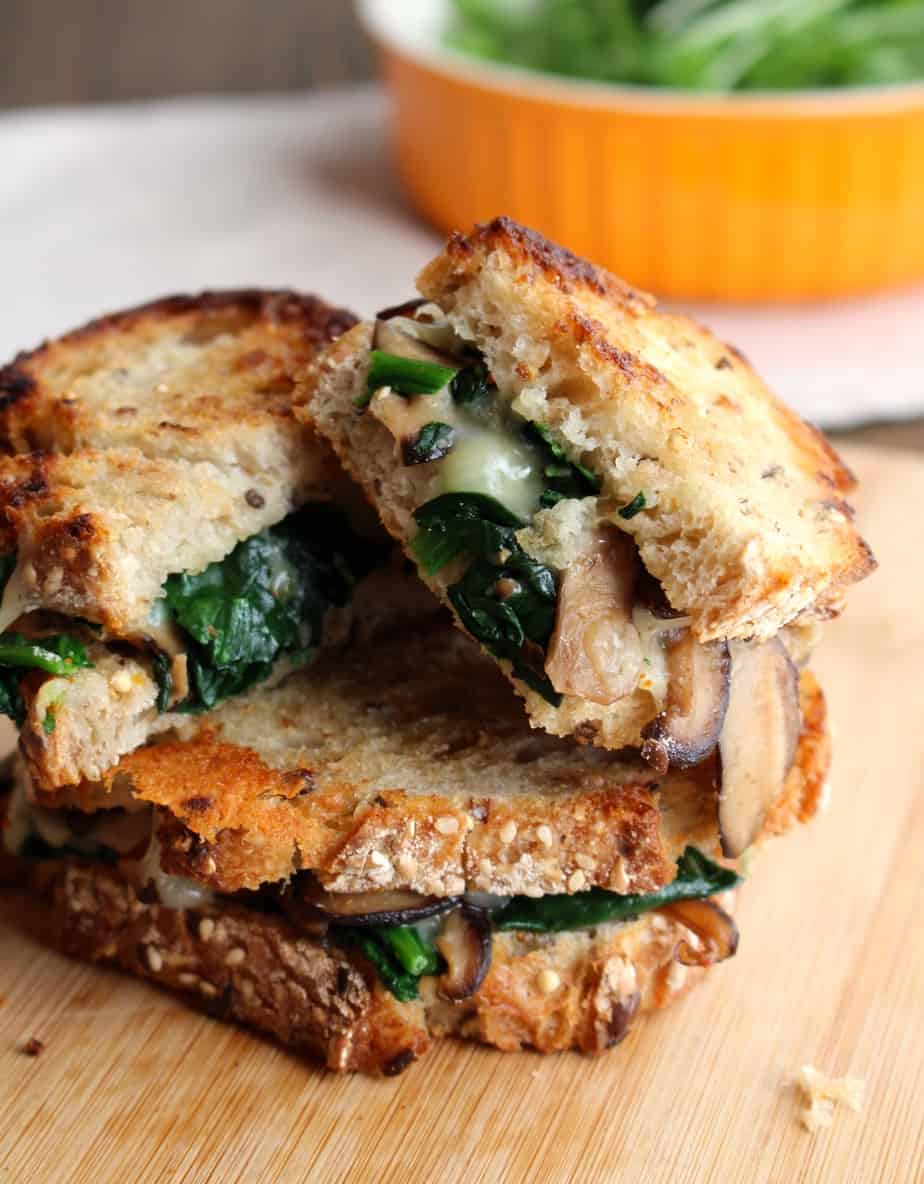
Mushroom Melt Grilled Cheese
From Frugal Nutrition
Here’s a quick and easy way to eat up the mushrooms and spinach from this week’s box, without turning on your oven. The recipe supplies a handy multiplier to help you figure amounts for up to six sandwiches.
.
.

Leafy Greens Pesto
From The Fountain Avenue Kitchen
As most CSA members most likely already know, you can make pesto with lots of other types of greens and herbs, not just basil. I’m pretty sure there’ve been recipes for kale and even broccoli pesto in prior newsletters. The nice thing about this recipe is that it provides proportions for using just about any type of greens, and there’s also a dairy-free variation.
.
.

Photo by Robby Lozano
Easy Upside Down Sheet-Pan Asparagus Tart
From Serious Eats
If you’re on Instagram, you’ve probably seen Dominic Franks’ upside down puff pastry recipes, as well as others. The topping/filling ingredients are laid on a pan, then covered with a sheet of puff pastry. This helps the toppings cook, for example in this recipe where there’s no need to precook the asparagus, and also helps the puff pastry rise and brown, then the dish is flipped for serving.


